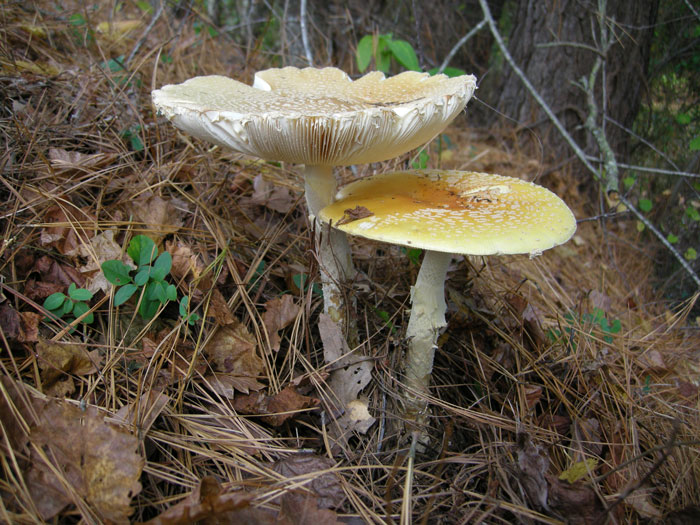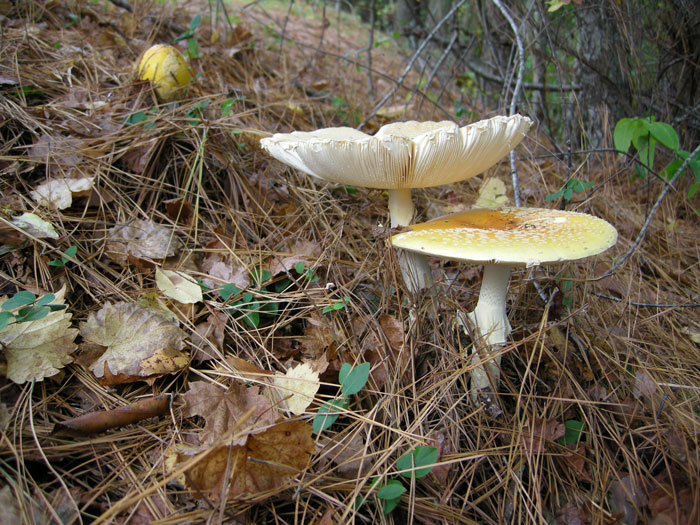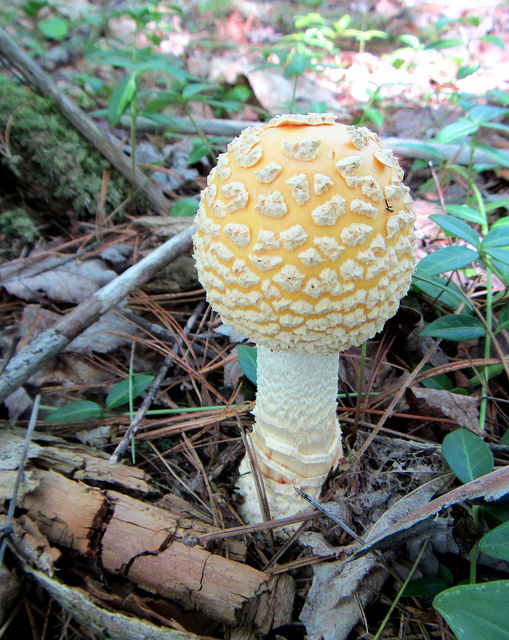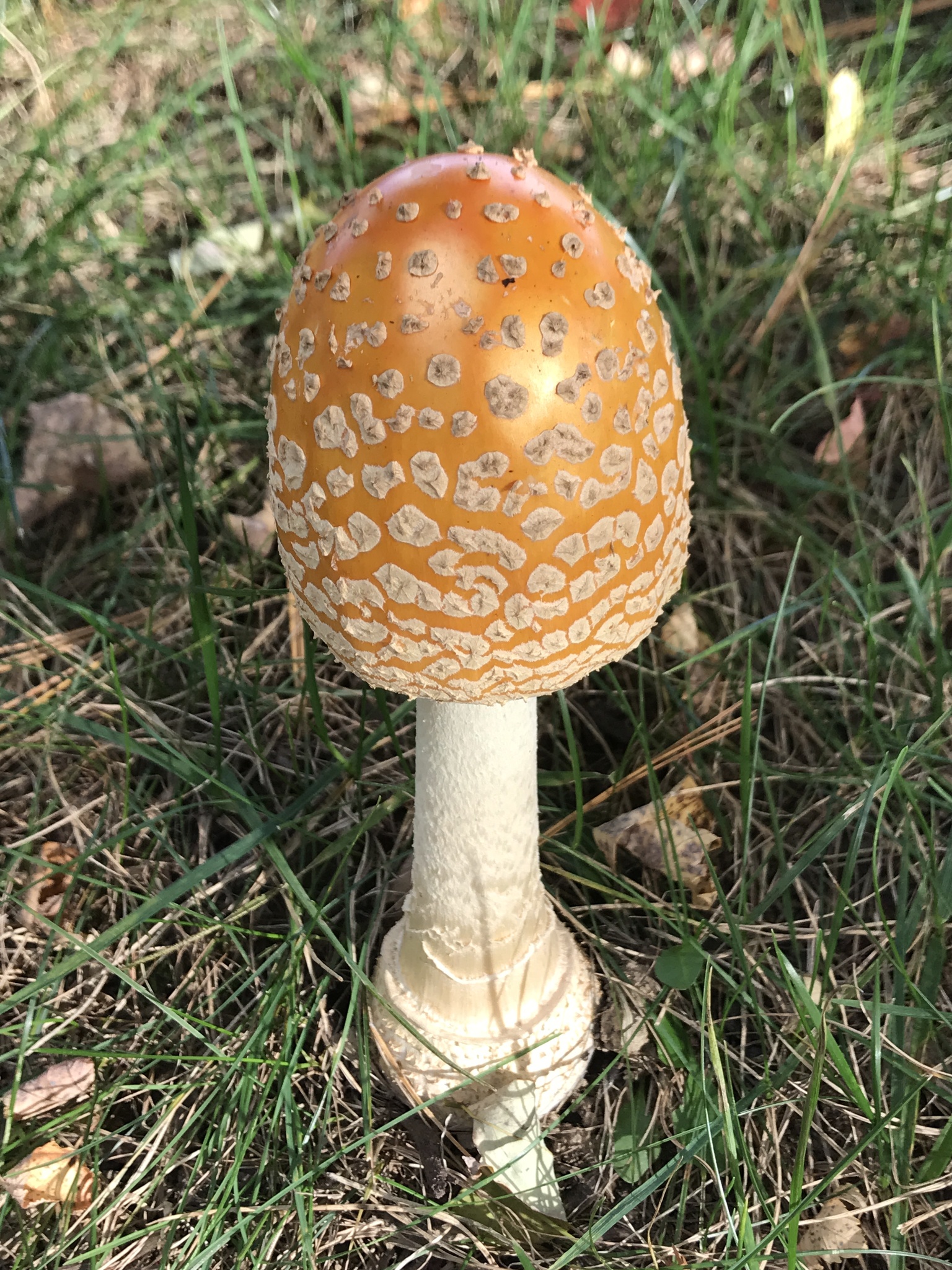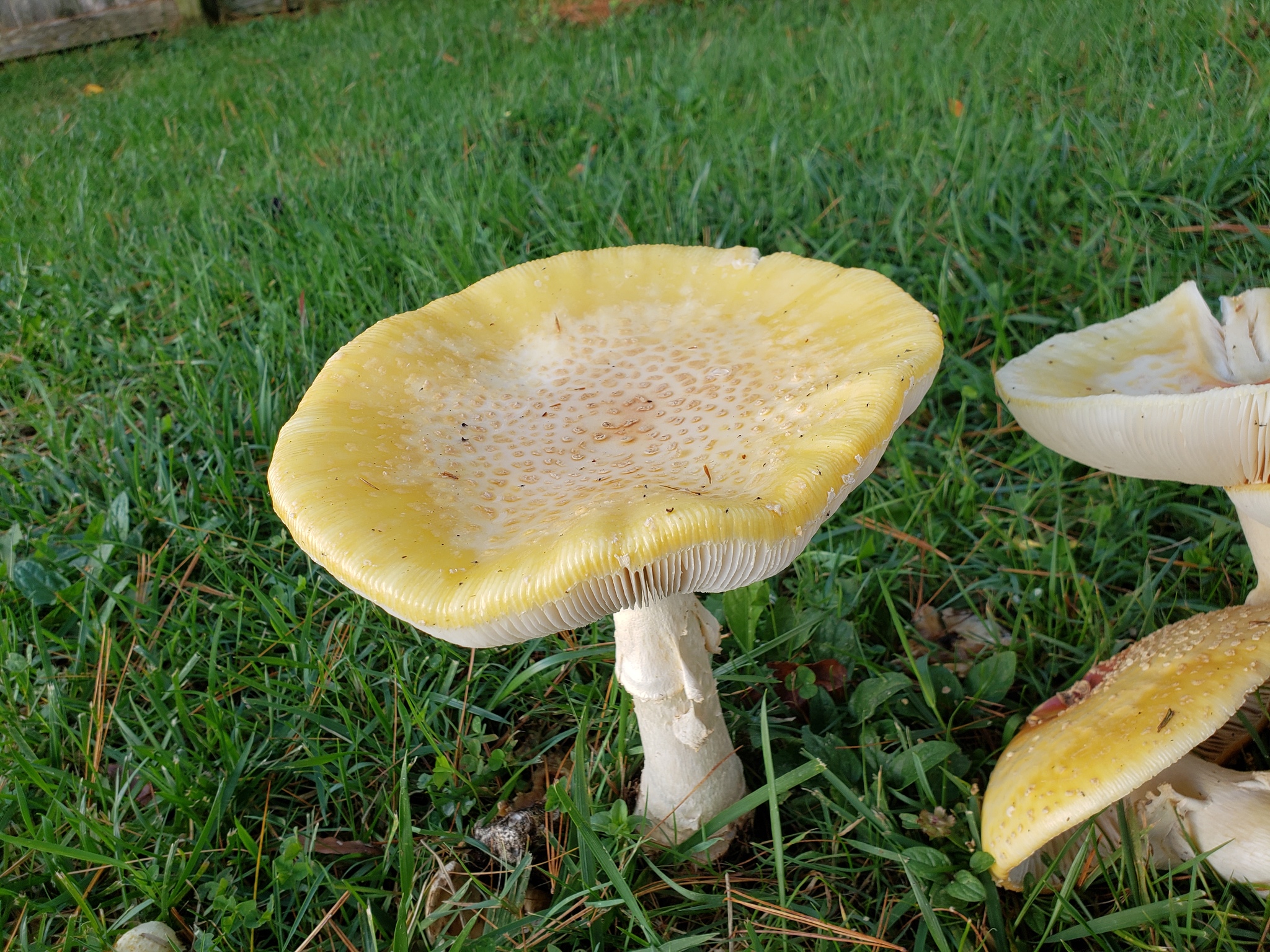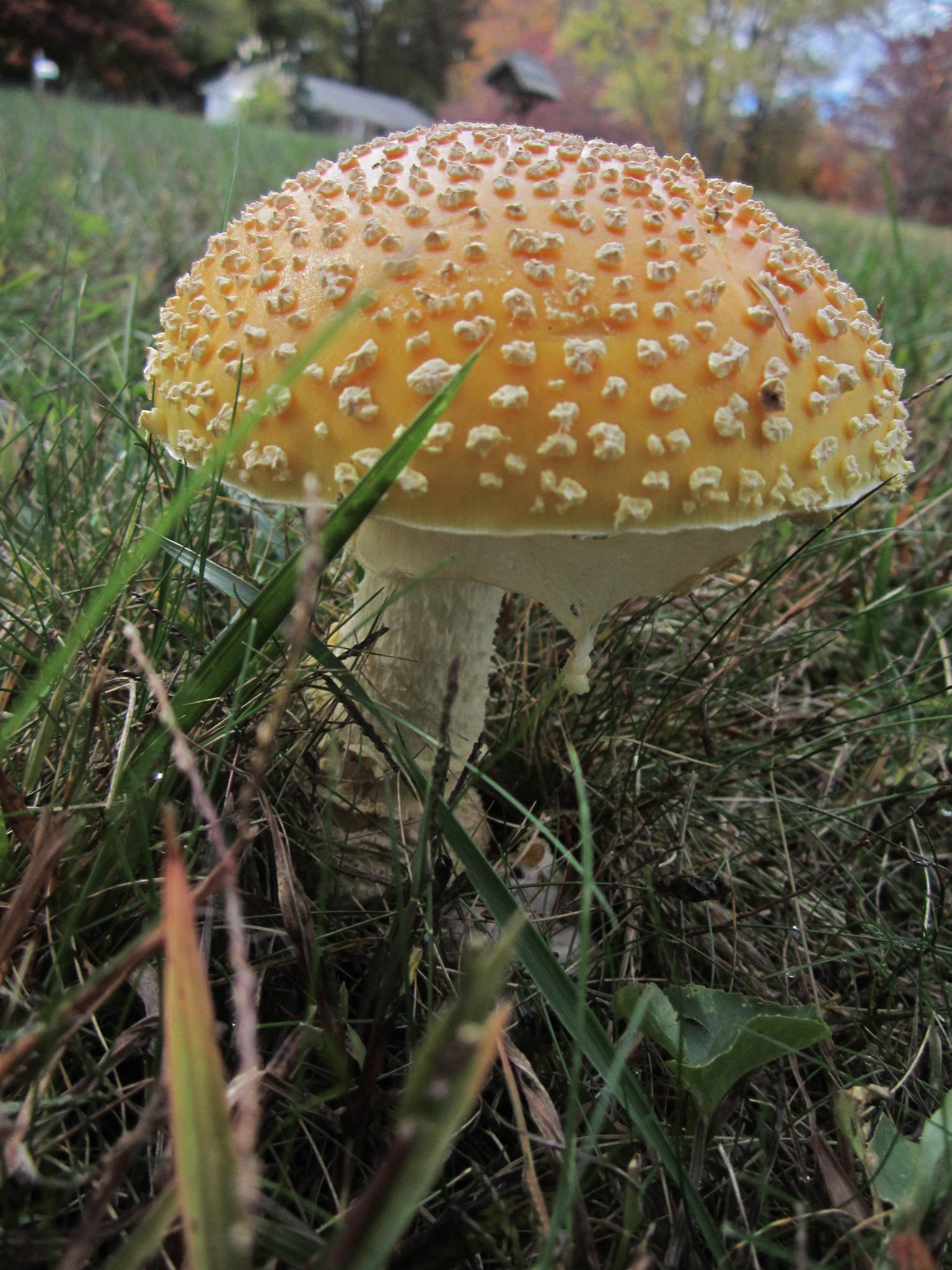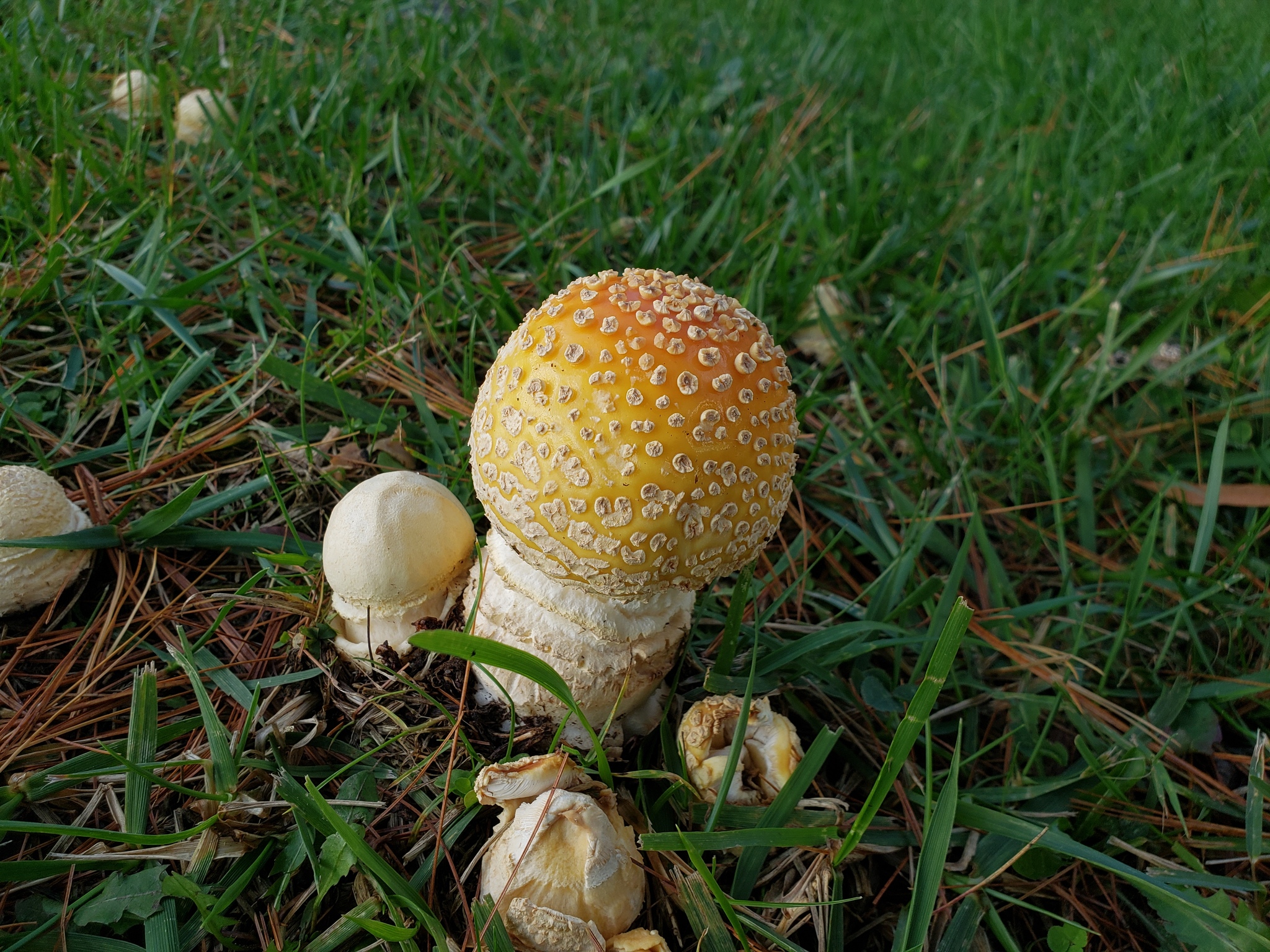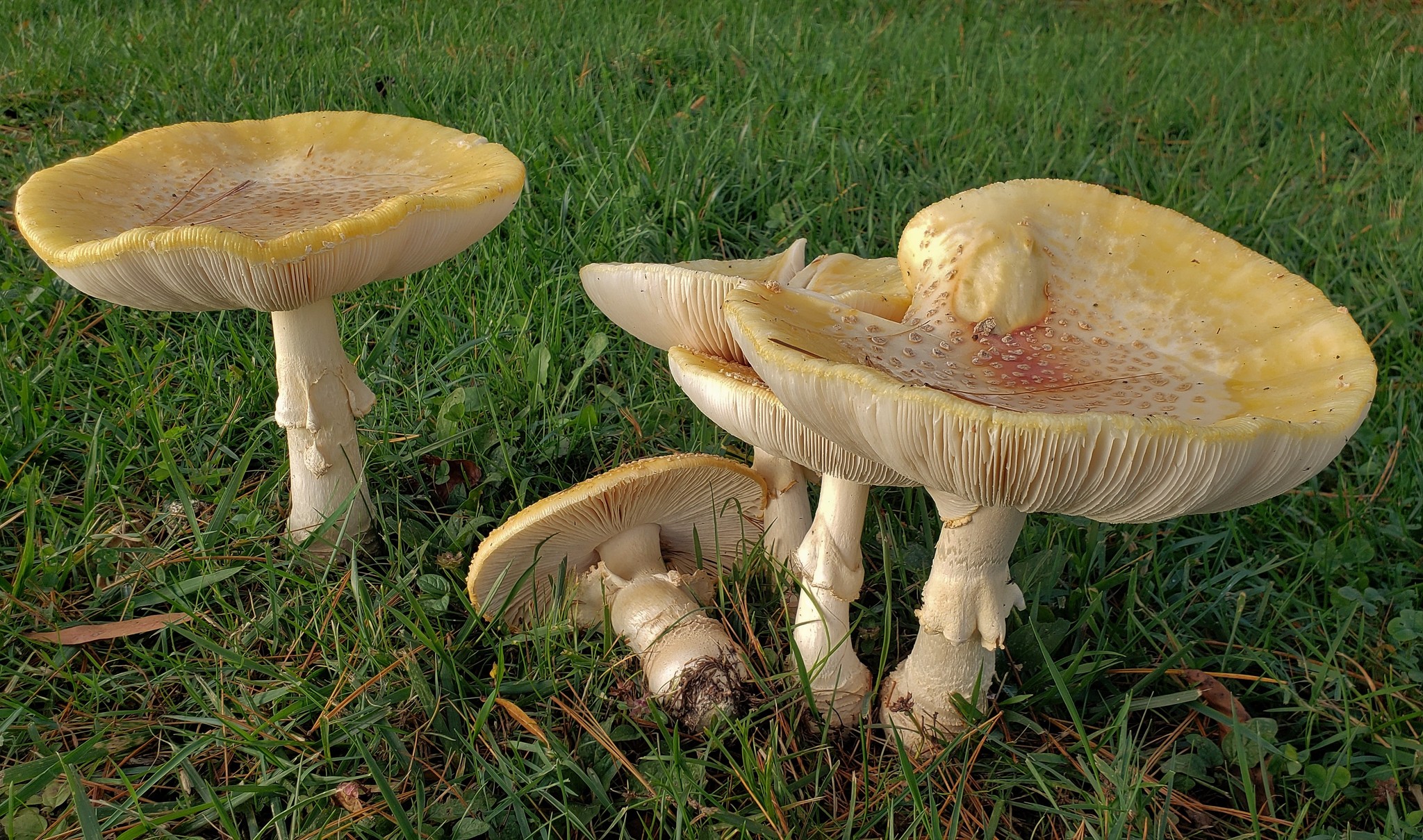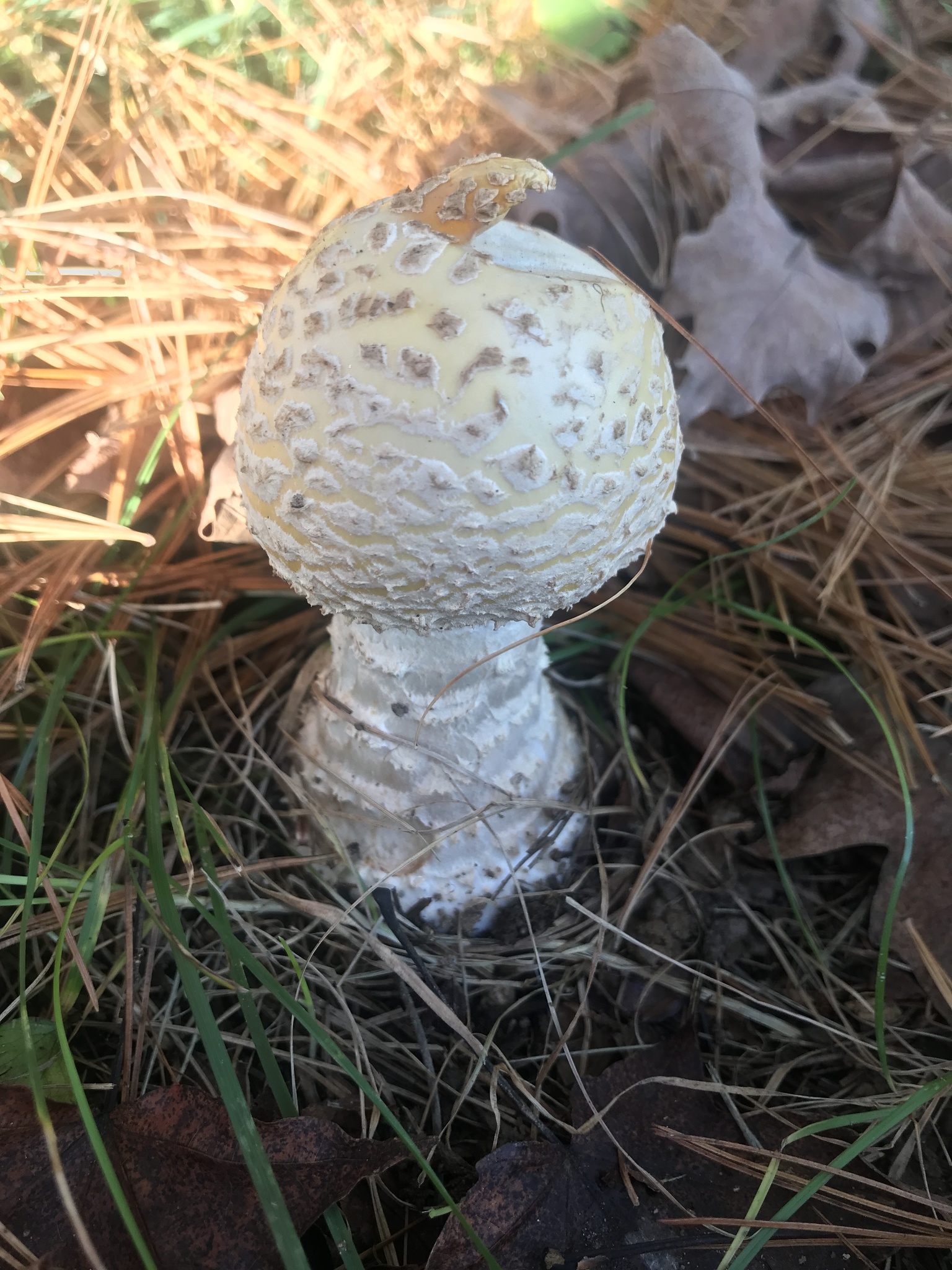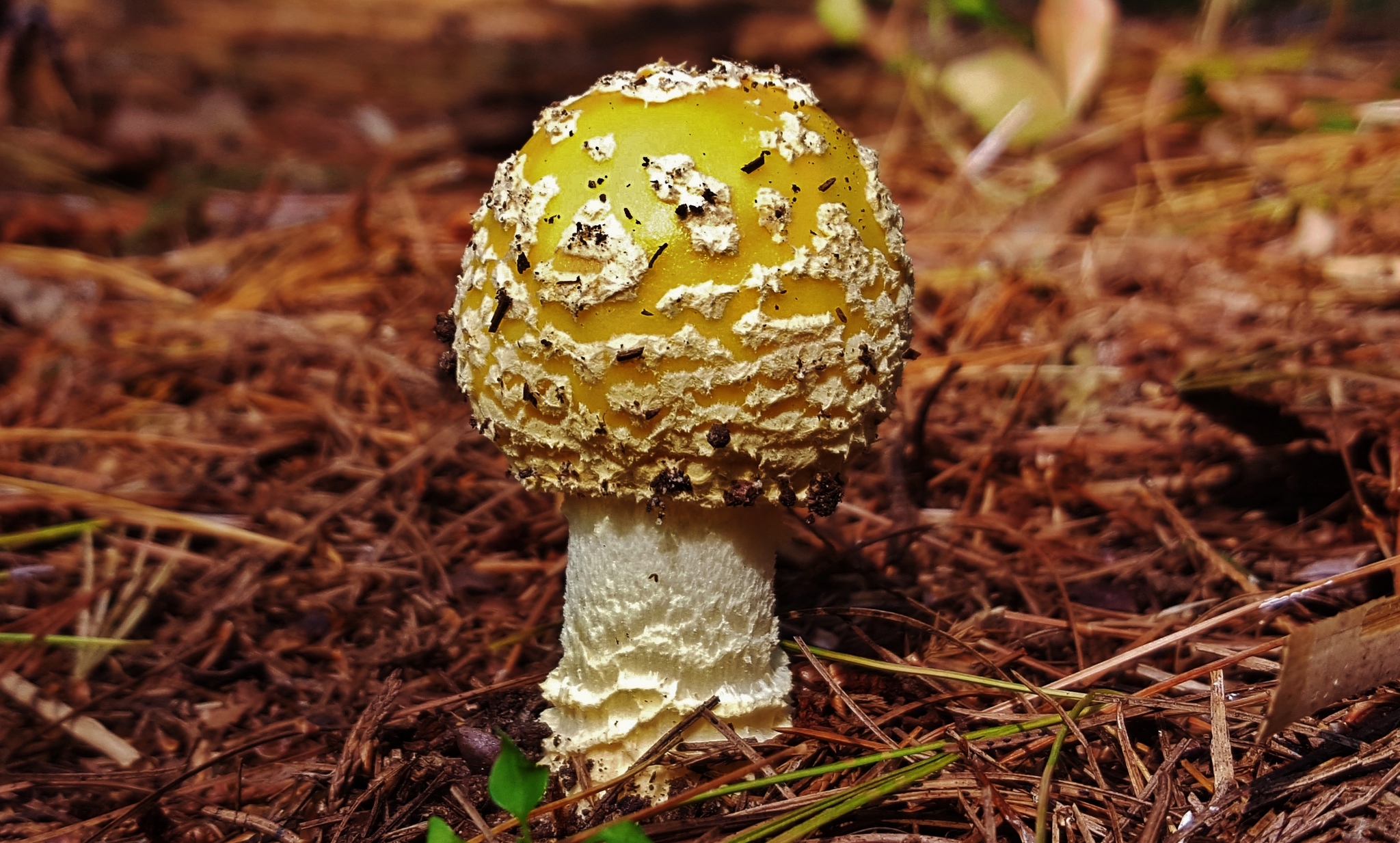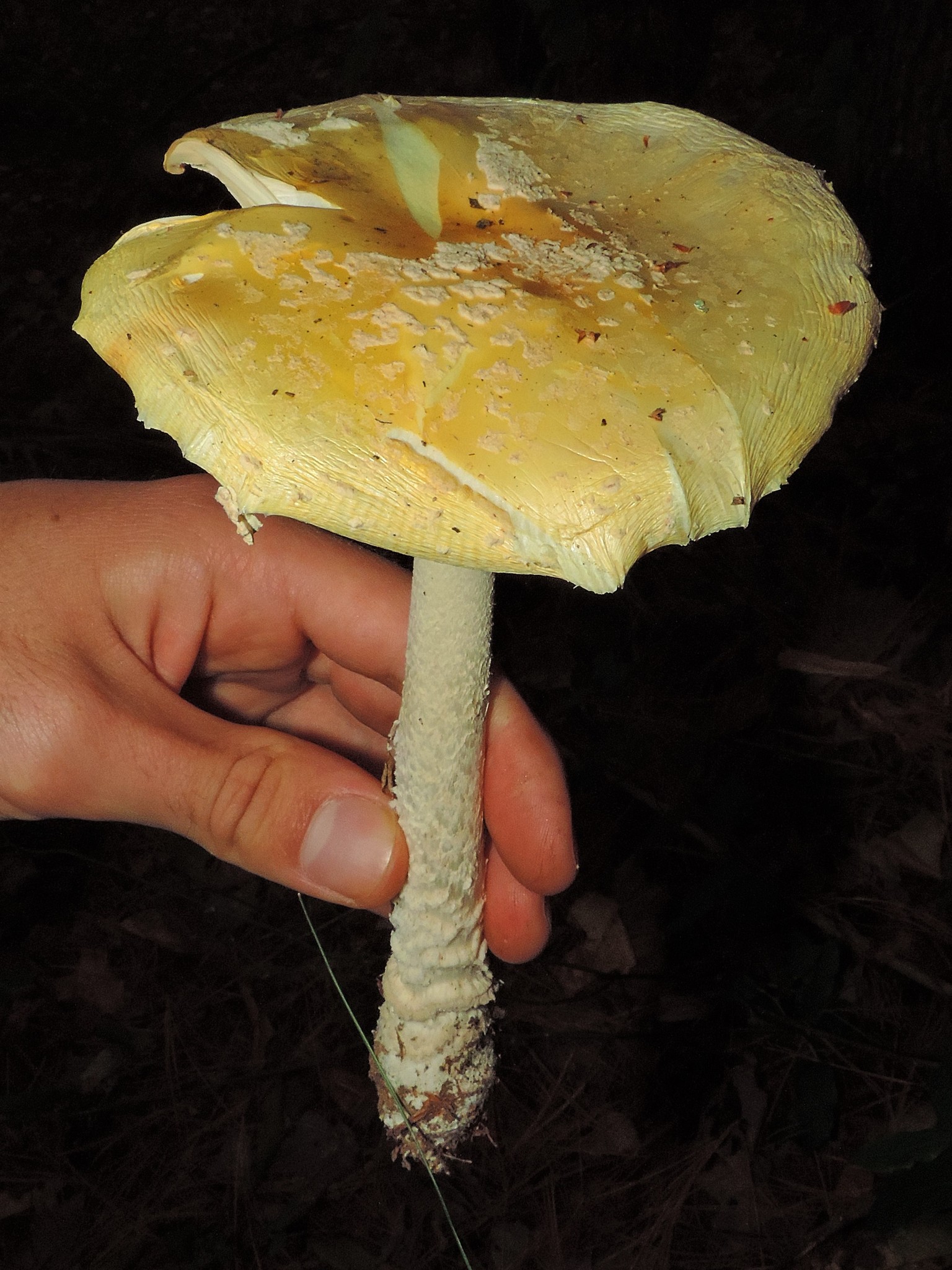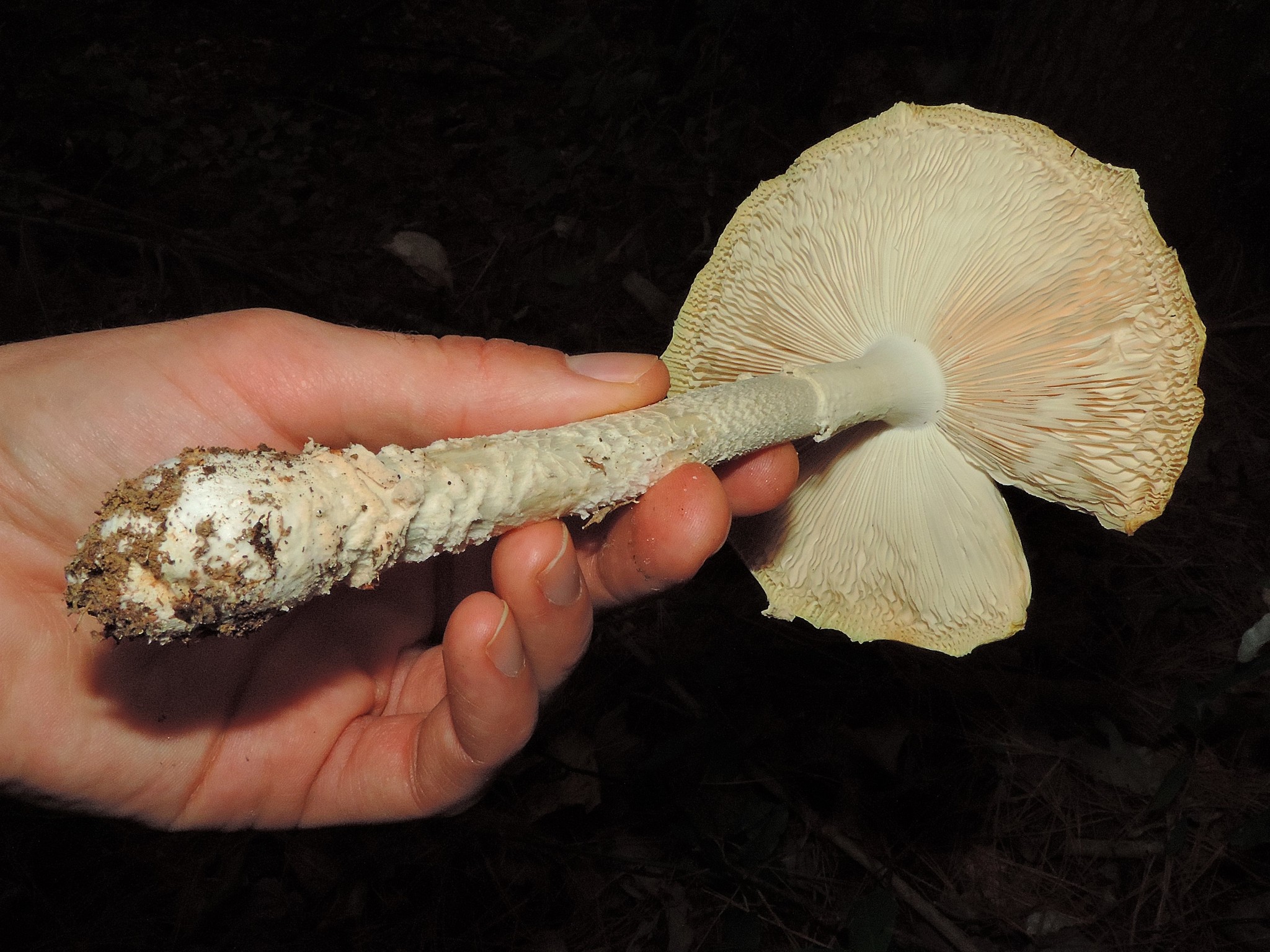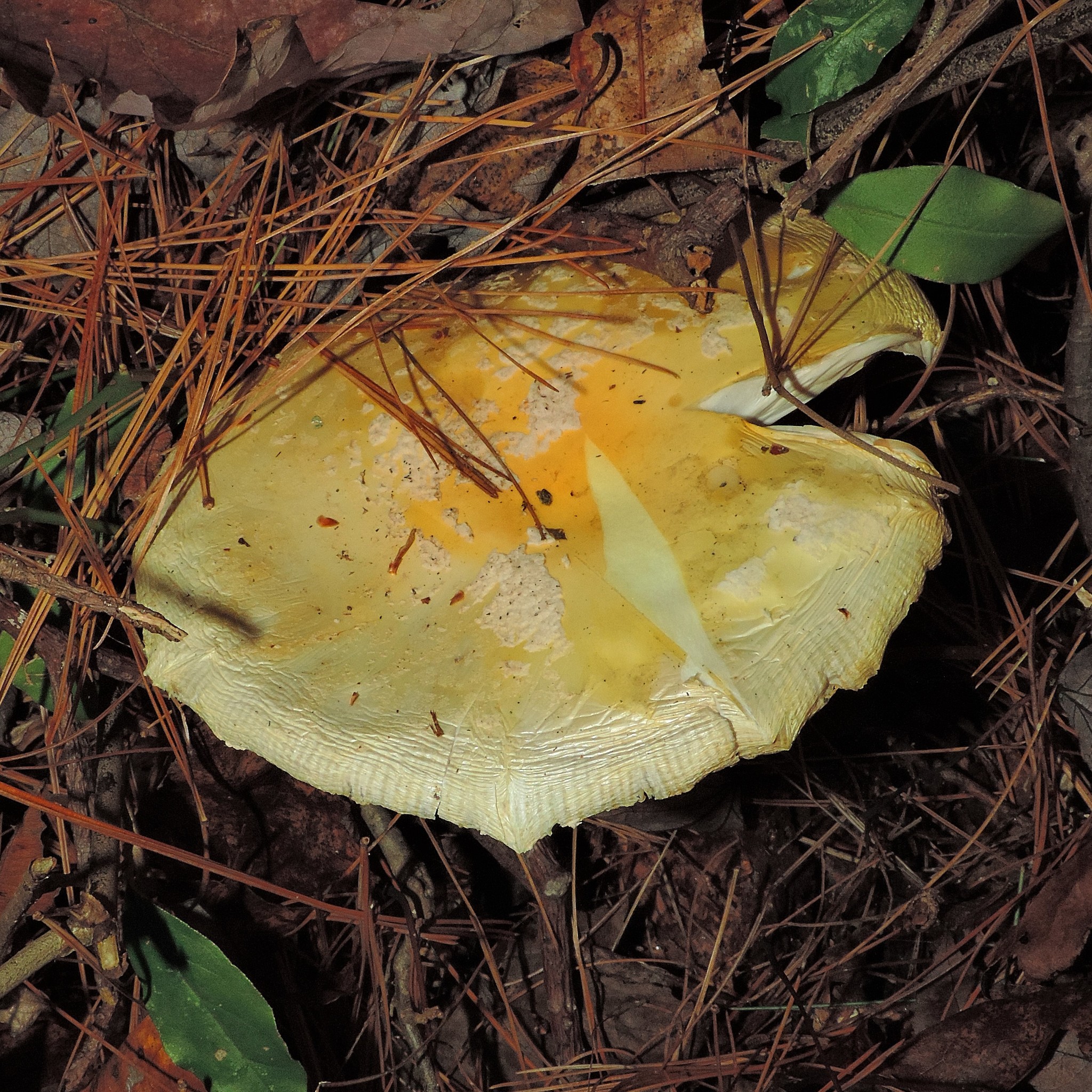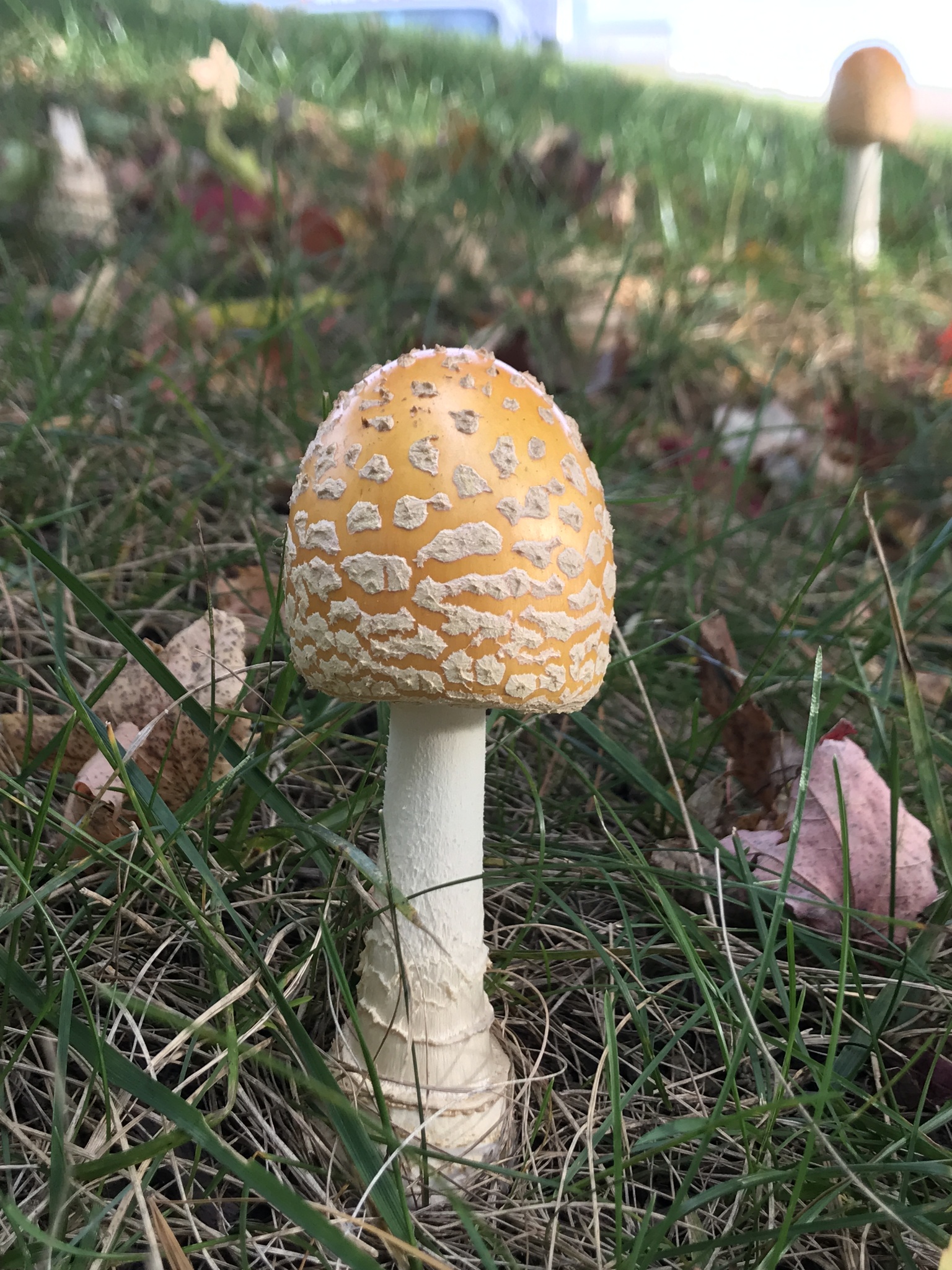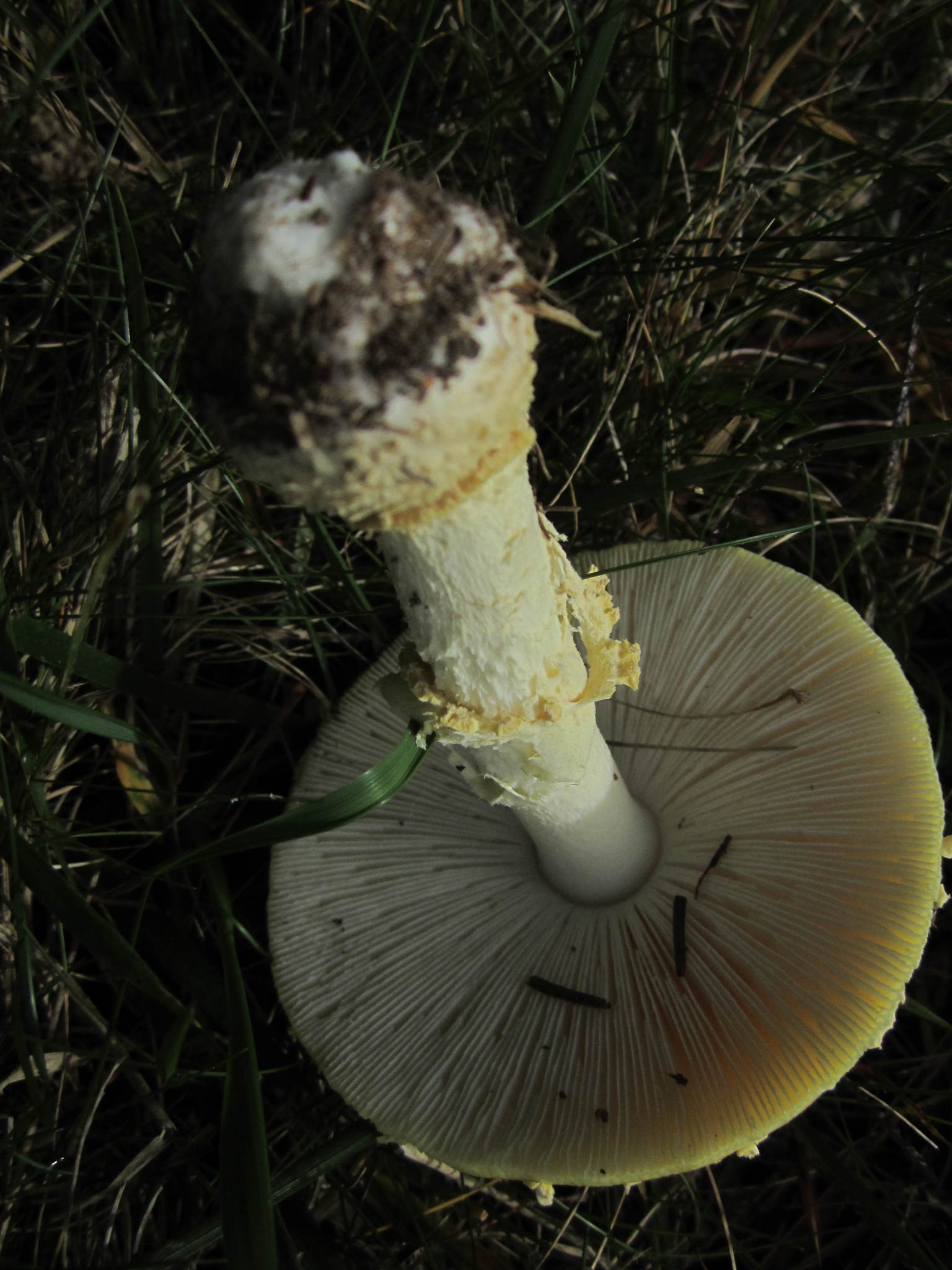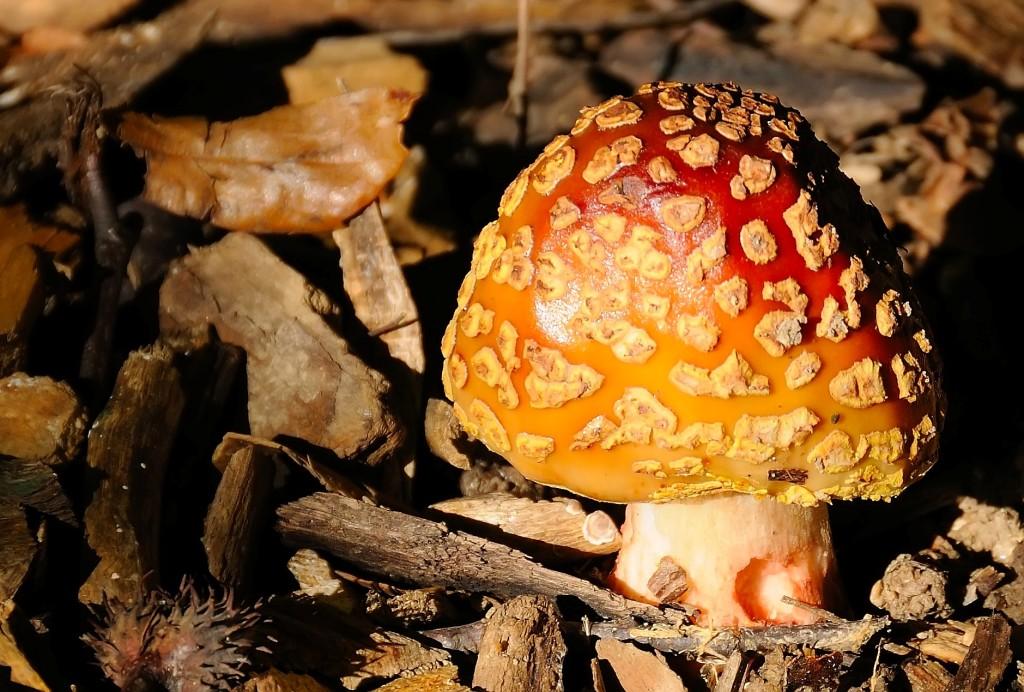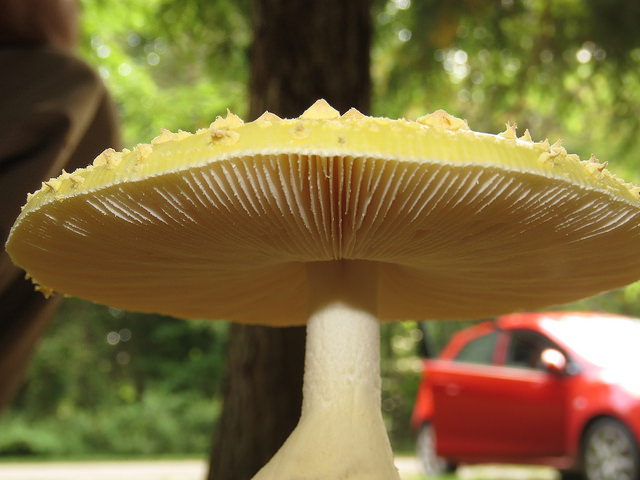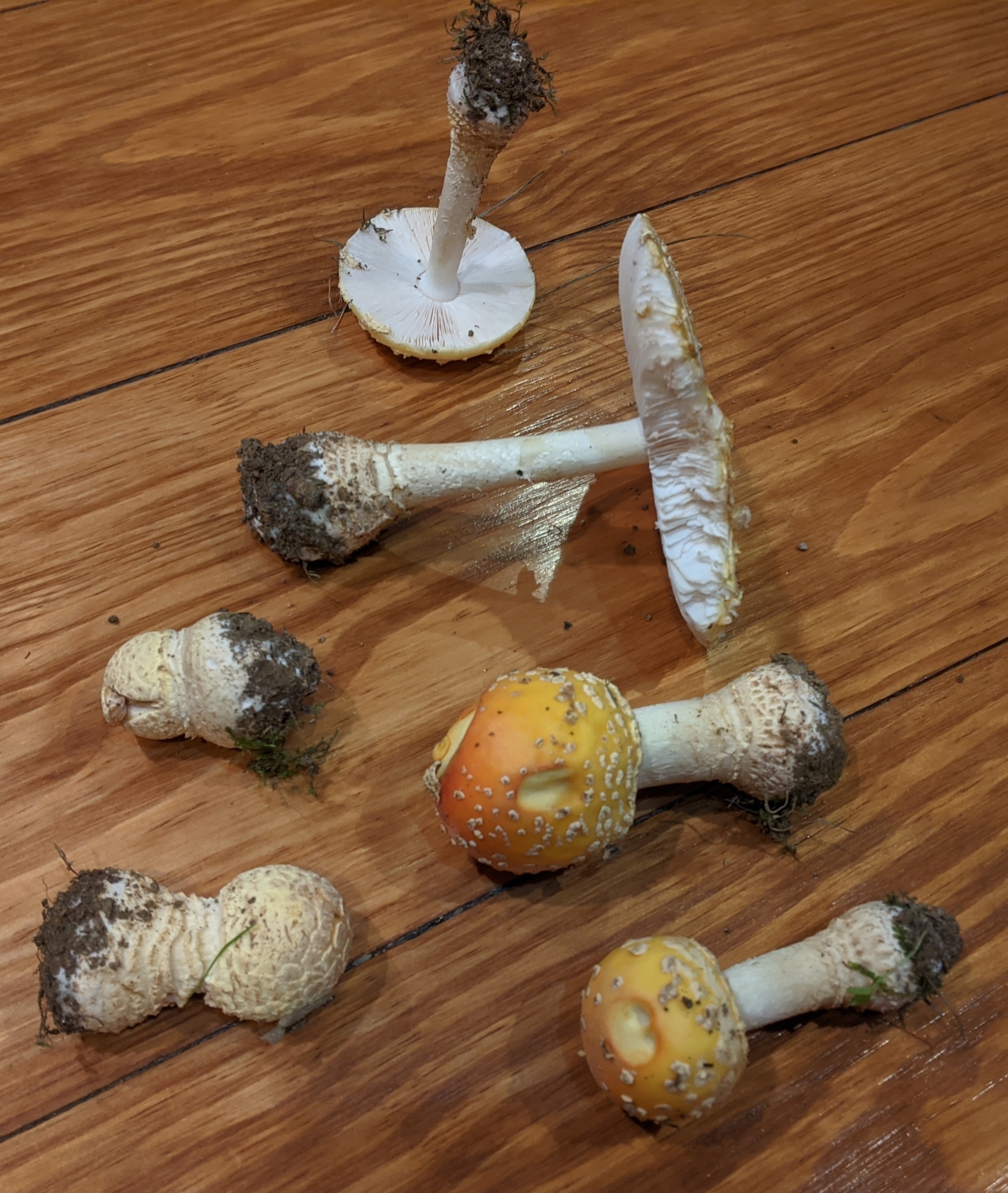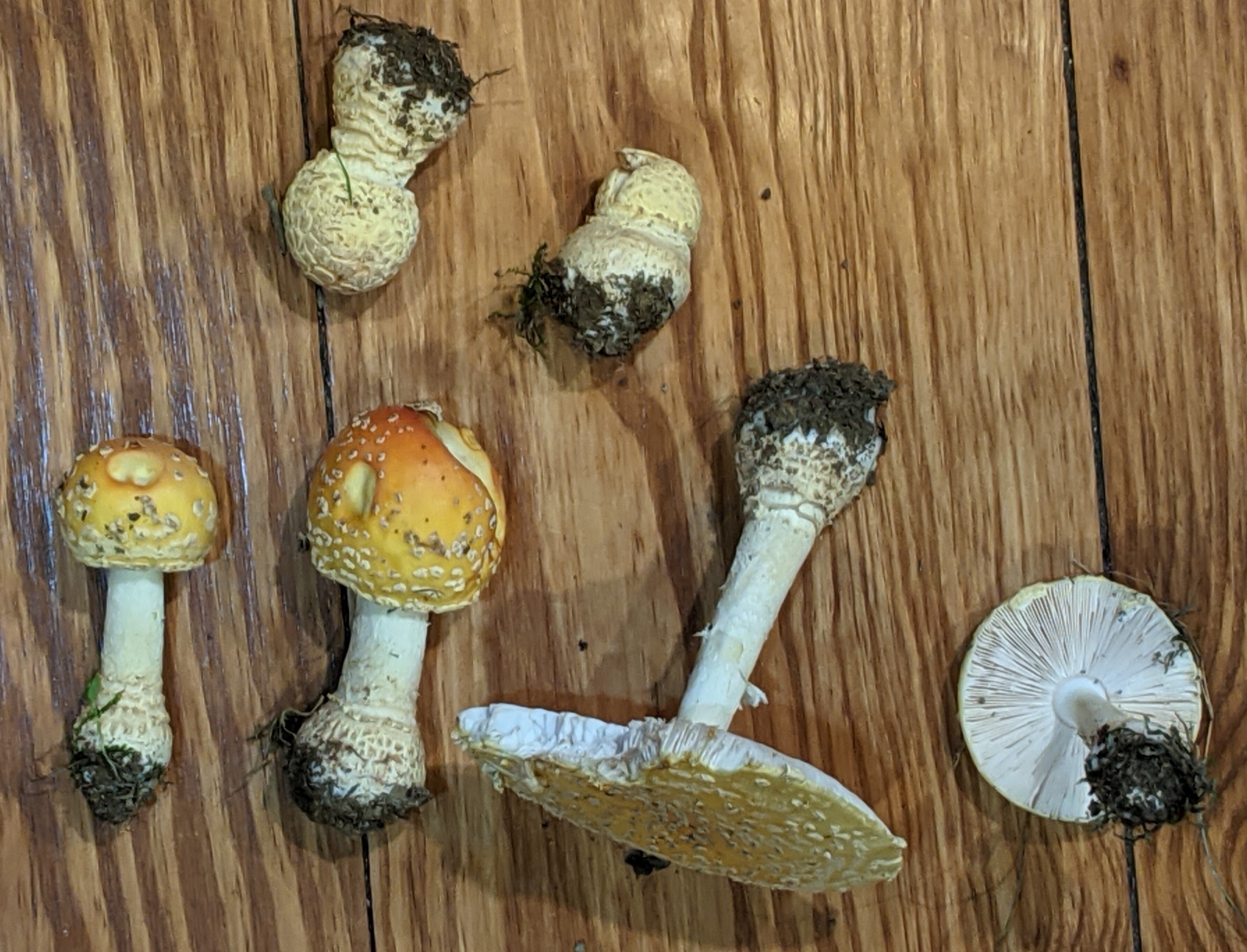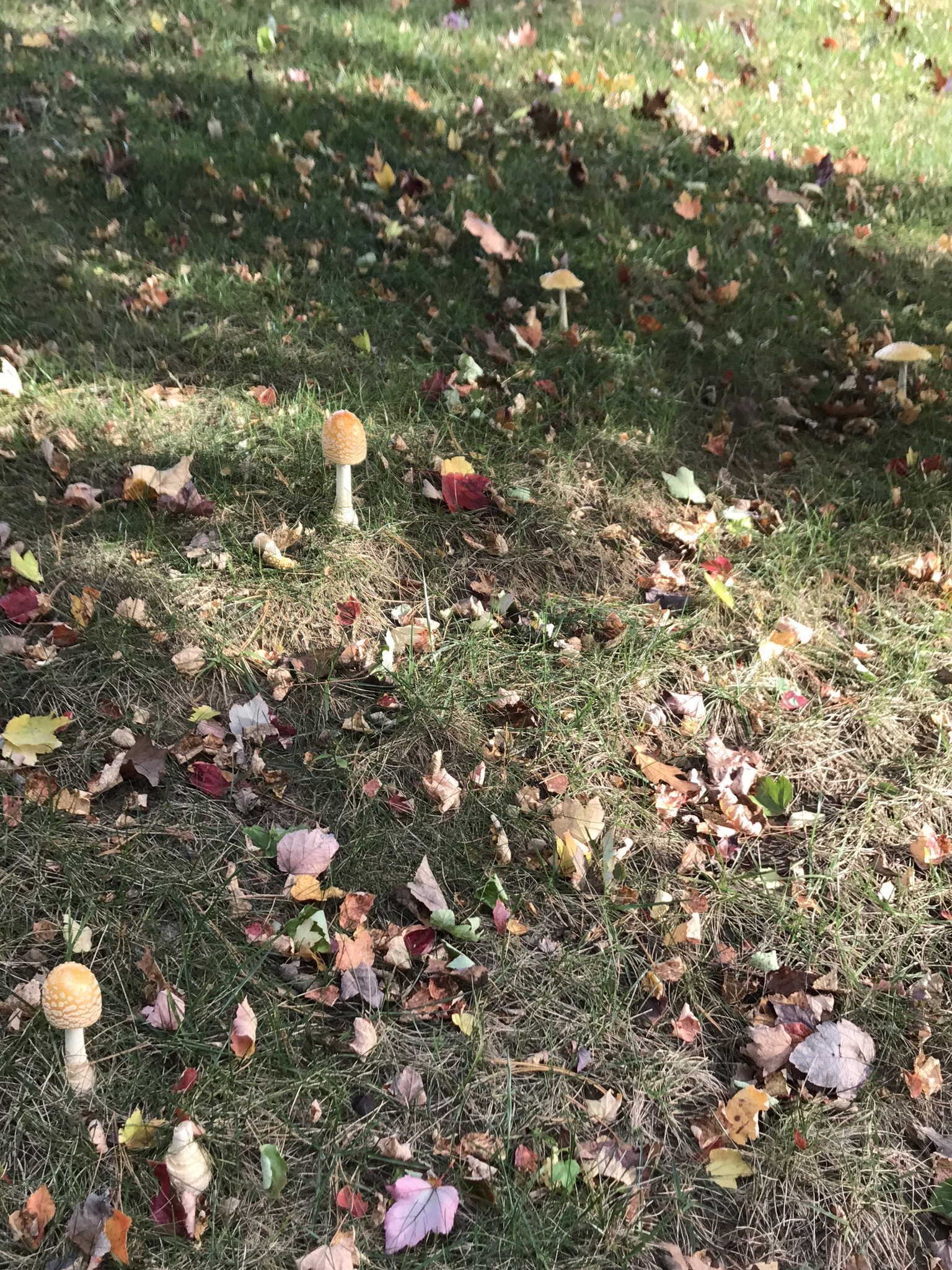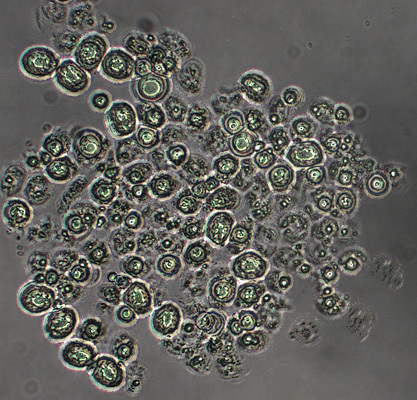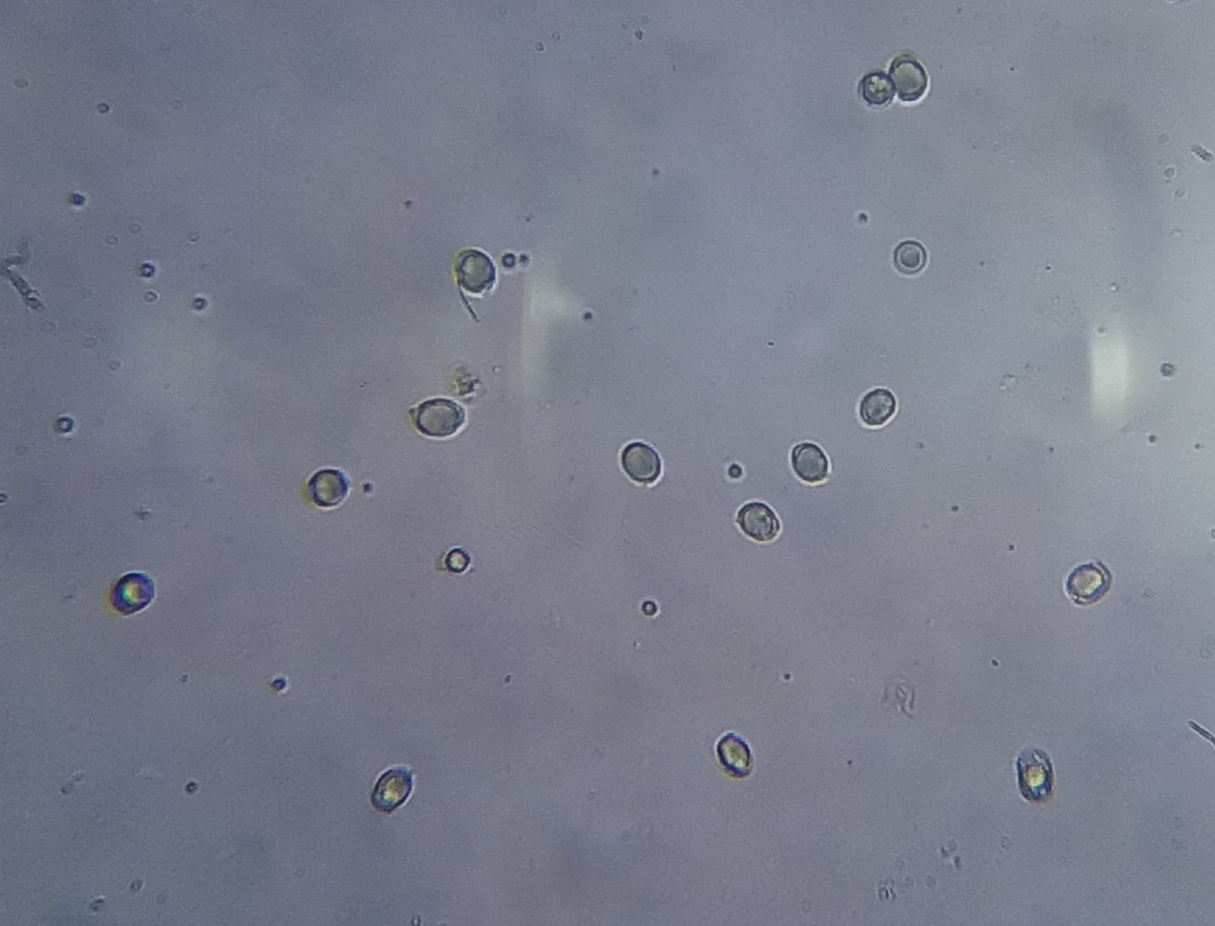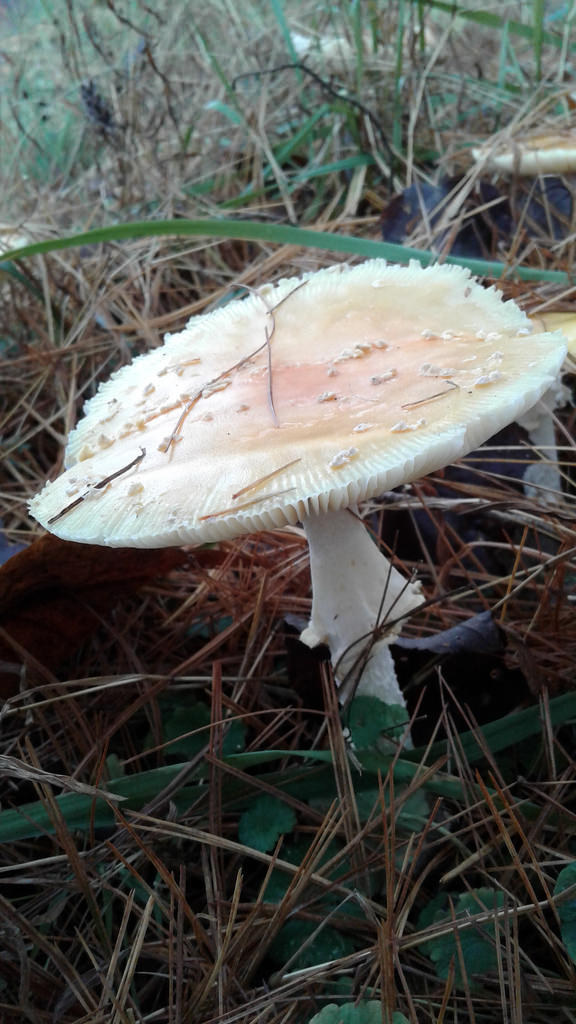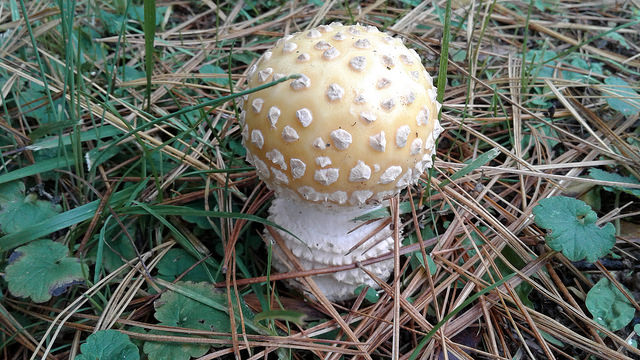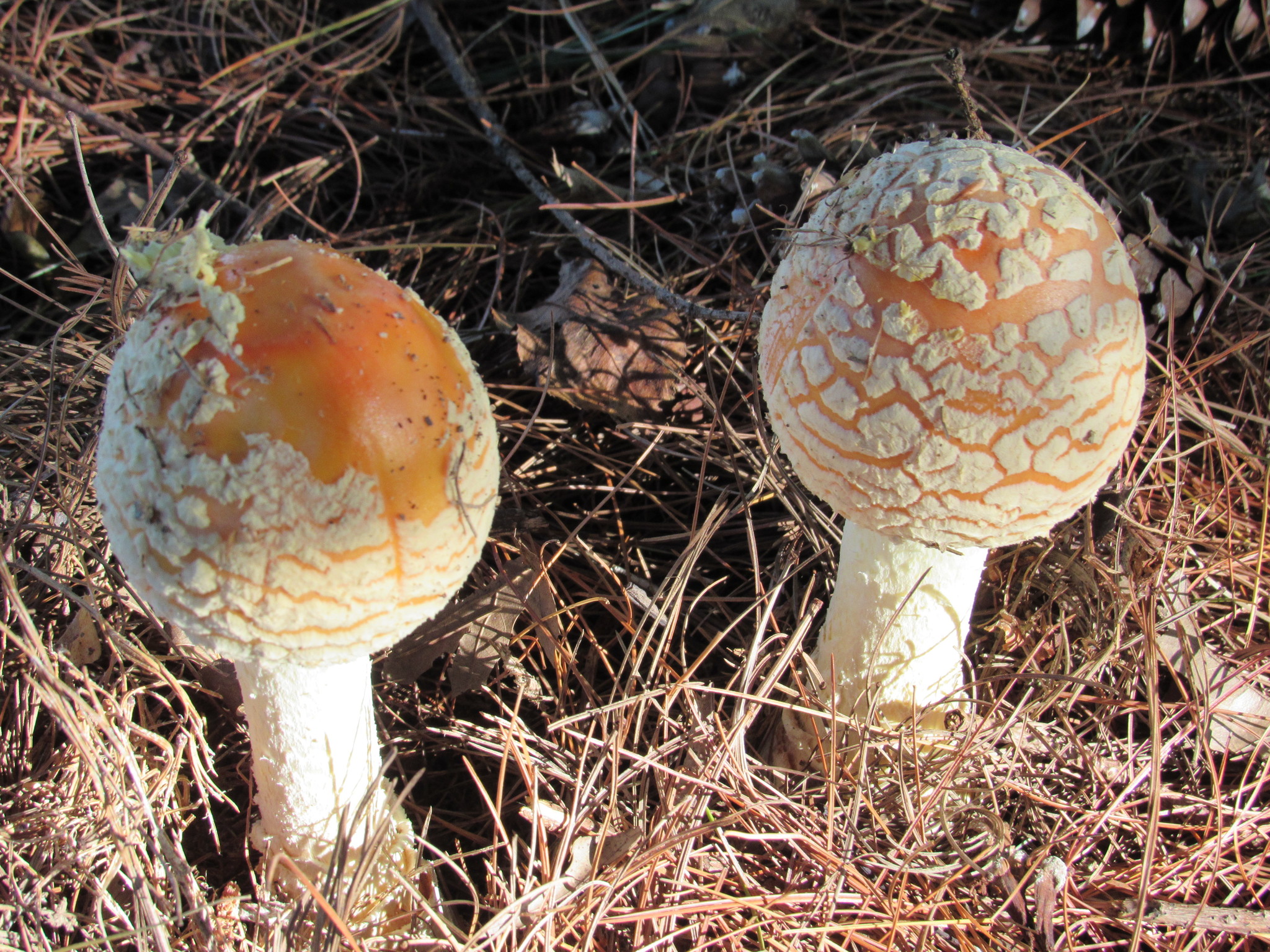Map Snapshot


















107 Records
Status
Although reported from Maryland historically, recent studies suggest that Amanita muscaria sensu stricto does not occur on the East Coast. Amanita muscaria var. guessowii is common in Maryland and treated as a synonym of Amanita muscaria for now (IndexFungorum, 12/2022). Other similar-looking species that occur in Maryland are Amanita flavoconia, Amanita frostiana, Amanita parcivolvata, and Amanita persicina.
Relationships
Although poisonous, it has a long history as an inebriant, used by the Russian shamans to induce visions among their tribe members. Because of its toxicity, it was eaten only by the holy men, who were said to be immune to its toxins and who would then distribute their urine around for its hallucinatory purposes. Other alleged uses, such as the cap being placed in a dish of milk to kill flies, has not been documented. (L. Biechele, pers. comm.)
Seasonality Snapshot
Source: Wikipedia
| Amanita muscaria | |
|---|---|

| |
| Showing three stages as the mushroom matures | |
| Scientific classification | |
| Domain: | Eukaryota |
| Kingdom: | Fungi |
| Division: | Basidiomycota |
| Class: | Agaricomycetes |
| Order: | Agaricales |
| Family: | Amanitaceae |
| Genus: | Amanita |
| Species: | A. muscaria
|
| Binomial name | |
| Amanita muscaria | |
| Subspecies and varieties | |
| |
| Amanita muscaria | |
|---|---|
| Gills on hymenium | |
| Cap is convex or flat | |
| Hymenium is free | |
| Stipe has a ring and volva | |
| Spore print is white | |
| Ecology is mycorrhizal | |
| Edibility is poisonous or psychoactive | |
Amanita muscaria, commonly known as the fly agaric or fly amanita,[5] is a basidiomycete of the genus Amanita. It is a large white-gilled, white-spotted, and usually red mushroom.
Despite its easily distinguishable features, A. muscaria is a fungus with several known variations, or subspecies. These subspecies are slightly different, some having yellow or white caps, but are all usually called fly agarics, most often recognizable by their notable white spots. Recent DNA fungi research, however, has shown that some mushrooms called "fly agaric" are in fact unique species, such as A. persicina (the peach-colored fly agaric).
Native throughout the temperate and boreal regions of the Northern Hemisphere, A. muscaria has been unintentionally introduced to many countries in the Southern Hemisphere, generally as a symbiont with pine and birch plantations, and is now a true cosmopolitan species. It associates with various deciduous and coniferous trees.
Although poisonous, death due to poisoning from A. muscaria ingestion is quite rare. Parboiling twice with water weakens its toxicity and breaks down the mushroom's psychoactive substances; it is eaten in parts of Europe, Asia, and North America. All A. muscaria varieties, but in particular A. muscaria var. muscaria, are noted for their hallucinogenic properties, with the main psychoactive constituents being muscimol and its neurotoxic precursor ibotenic acid. A local variety of the mushroom was used as an intoxicant and entheogen by the indigenous peoples of Siberia.[6][7]
Arguably the most iconic toadstool species, the fly agaric is one of the most recognizable fungi in the world, and is widely encountered in popular culture, including in video games—for example, the frequent use of a recognizable A. muscaria in the Mario franchise (e.g. its Super Mushroom power-up)—and television—for example, the houses in The Smurfs franchise.[8] There have been cases of children admitted to hospitals after consuming this poisonous mushroom; the children may have been attracted to it because of its pop-culture associations.[9]
Taxonomy
[edit]The name of the mushroom in many European languages is thought to derive from its use as an insecticide when sprinkled in milk. This practice has been recorded from Germanic- and Slavic-speaking parts of Europe, as well as the Vosges region and pockets elsewhere in France, and Romania.[10] Albertus Magnus was the first to record it in his work De vegetabilibus some time before 1256,[11] commenting "vocatur fungus muscarum, eo quod in lacte pulverizatus interficit muscas" ("it is called the fly mushroom because it is powdered in milk to kill flies").[12]

The 16th-century Flemish botanist Carolus Clusius traced the practice of sprinkling it into milk to Frankfurt in Germany,[13] while Carl Linnaeus, the "father of taxonomy", reported it from Småland in southern Sweden, where he had lived as a child.[14] He described it in volume two of his Species Plantarum in 1753, giving it the name Agaricus muscarius,[15] the specific epithet deriving from Latin musca meaning "fly".[16] It gained its current name in 1783, when placed in the genus Amanita by Jean-Baptiste Lamarck, a name sanctioned in 1821 by the "father of mycology", Swedish naturalist Elias Magnus Fries. The starting date for all the mycota had been set by general agreement as January 1, 1821, the date of Fries's work, and so the full name was then Amanita muscaria (L.:Fr.) Hook. The 1987 edition of the International Code of Botanical Nomenclature changed the rules on the starting date and primary work for names of fungi, and names can now be considered valid as far back as May 1, 1753, the date of publication of Linnaeus's work.[17] Hence, Linnaeus and Lamarck are now taken as the namers of Amanita muscaria (L.) Lam..
The English mycologist John Ramsbottom reported that Amanita muscaria was used for getting rid of bugs in England and Sweden, and bug agaric was an old alternative name for the species.[12] French mycologist Pierre Bulliard reported having tried without success to replicate its fly-killing properties in his work Histoire des plantes vénéneuses et suspectes de la France (1784), and proposed a new binomial name Agaricus pseudo-aurantiacus because of this.[18] One compound isolated from the fungus is 1,3-diolein (1,3-di(cis-9-octadecenoyl)glycerol), which attracts insects.[19] It has been hypothesised that the flies intentionally seek out the fly agaric for its intoxicating properties.[20] An alternative derivation proposes that the term fly- refers not to insects as such but rather the delirium resulting from consumption of the fungus. This is based on the medieval belief that flies could enter a person's head and cause mental illness.[21] Several regional names appear to be linked with this connotation, meaning the "mad" or "fool's" version of the highly regarded edible mushroom Amanita caesarea. Hence there is oriol foll "mad oriol" in Catalan, mujolo folo from Toulouse, concourlo fouolo from the Aveyron department in Southern France, ovolo matto from Trentino in Italy. A local dialect name in Fribourg in Switzerland is tsapi de diablhou, which translates as "Devil's hat".[22]
Classification
[edit]Amanita muscaria is the type species of the genus. By extension, it is also the type species of Amanita subgenus Amanita, as well as section Amanita within this subgenus. Amanita subgenus Amanita includes all Amanita with inamyloid spores. Amanita section Amanita includes the species with patchy universal veil remnants, including a volva that is reduced to a series of concentric rings, and the veil remnants on the cap to a series of patches or warts. Most species in this group also have a bulbous base.[23][24] Amanita section Amanita consists of A. muscaria and its close relatives, including A. pantherina (the panther cap), A. gemmata, A. farinosa, and A. xanthocephala.[25] Modern fungal taxonomists have classified Amanita muscaria and its allies this way based on gross morphology and spore inamyloidy. Two recent molecular phylogenetic studies have confirmed this classification as natural.[26][27]
Description
[edit]
A large, conspicuous mushroom, Amanita muscaria is generally common and numerous where it grows, and is often found in groups with basidiocarps in all stages of development. Fly agaric fruiting bodies emerge from the soil looking like white eggs. After emerging from the ground, the cap is covered with numerous small white to yellow pyramid-shaped warts. These are remnants of the universal veil, a membrane that encloses the entire mushroom when it is still very young. Dissecting the mushroom at this stage reveals a characteristic yellowish layer of skin under the veil, which helps identification. As the fungus grows, the red colour appears through the broken veil and the warts become less prominent; they do not change in size, but are reduced relative to the expanding skin area. The cap changes from globose to hemispherical, and finally to plate-like and flat in mature specimens.[28] Fully grown, the bright red cap is usually around 8–20 centimetres (3–8 inches) in diameter, although larger specimens have been found. The red colour may fade after rain and in older mushrooms.
The free gills are white, as is the spore print. The oval spores measure 9–13 by 6.5–9 μm; they do not turn blue with the application of iodine.[29] The stipe is white, 5–20 cm (2–8 in) high[30] by 1–2 cm (1⁄2–1 in) wide, and has the slightly brittle, fibrous texture typical of many large mushrooms. At the base is a bulb that bears universal veil remnants in the form of two to four distinct rings or ruffs. Between the basal universal veil remnants and gills are remnants of the partial veil (which covers the gills during development) in the form of a white ring. It can be quite wide and flaccid with age. There is generally no associated smell other than a mild earthiness.[31][32]

Although very distinctive in appearance, the fly agaric has been mistaken for other yellow to red mushroom species in the Americas, such as Armillaria cf. mellea and the edible A. basii—a Mexican species similar to A. caesarea of Europe. Poison control centres in the U.S. and Canada have become aware that amarill (Spanish for 'yellow') is a common name for the A. caesarea-like species in Mexico.[4] A. caesarea is distinguished by its entirely orange to red cap, which lacks the numerous white warty spots of the fly agaric (though these sometimes wash away during heavy rain).[33] Furthermore, the stem, gills and ring of A. caesarea are bright yellow, not white.[34] The volva is a distinct white bag, not broken into scales.[35] In Australia, the introduced fly agaric may be confused with the native vermilion grisette (Amanita xanthocephala), which grows in association with eucalypts. The latter species generally lacks the white warts of A. muscaria and bears no ring.[36] Additionally, immature button forms resemble puffballs.[37]
Controversy
[edit]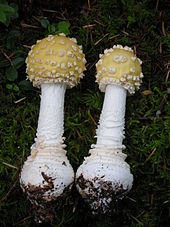
Amanita muscaria varies considerably in its morphology, and many authorities recognize several subspecies or varieties within the species. In The Agaricales in Modern Taxonomy, German mycologist Rolf Singer listed three subspecies, though without description: A. muscaria ssp. muscaria, A. muscaria ssp. americana, and A. muscaria ssp. flavivolvata.[23]
However, a 2006 molecular phylogenetic study of different regional populations of A. muscaria by mycologist József Geml and colleagues found three distinct clades within this species representing, roughly, Eurasian, Eurasian "subalpine", and North American populations. Specimens belonging to all three clades have been found in Alaska; this has led to the hypothesis that this was the centre of diversification for this species. The study also looked at four named varieties of the species: var. alba, var. flavivolvata, var. formosa (including var. guessowii), and var. regalis from both areas. All four varieties were found within both the Eurasian and North American clades, evidence that these morphological forms are polymorphisms rather than distinct subspecies or varieties.[38] Further molecular study by Geml and colleagues published in 2008 show that these three genetic groups, plus a fourth associated with oak–hickory–pine forest in the southeastern United States and two more on Santa Cruz Island in California, are delineated from each other enough genetically to be considered separate species. Thus A. muscaria as it stands currently is, evidently, a species complex.[39] The complex also includes at least three other closely related taxa that are currently regarded as species:[1] A. breckonii is a buff-capped mushroom associated with conifers from the Pacific Northwest,[40] and the brown-capped A. gioiosa and A. heterochroma from the Mediterranean Basin and from Sardinia respectively. Both of these last two are found with Eucalyptus and Cistus trees, and it is unclear whether they are native or introduced from Australia.[41][42]
Amanitaceae.org lists four varieties as of May 2019[update], but says that they will be segregated into their own taxa "in the near future". They are:[2]
| Image | Reference name | Common name | Synonym | Description |
|---|---|---|---|---|

|
Amanita muscaria var. muscaria[1] | Euro-Asian fly agaric | Bright red fly agaric from northern Europe and Asia. Cap might be orange or yellow due to slow development of the purple pigment. Wide cap with white or yellow warts which are removed by rain.
Known to be toxic but used by shamans in northern cultures. Associated predominantly with Birch and diverse conifers in forest. | |

|
Amanita muscaria subsp. flavivolvata[3] | American fly agaric | red, with yellow to yellowish-white warts. It is found from southern Alaska down through the Rocky Mountains, through Central America, all the way to Andean Colombia. Rodham Tulloss uses this name to describe all "typical" A. muscaria from indigenous New World populations. | |
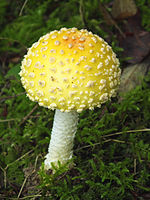
|
Amanita muscaria var. guessowii[4] | American fly agaric (yellow variant) | Amanita muscaria var. formosa | has a yellow to orange cap, with the centre more orange or perhaps even reddish orange. It is found most commonly in northeastern North America, from Newfoundland and Quebec south all the way to the state of Tennessee. Some authorities (cf. Jenkins) treat these populations as A. muscaria var. formosa, while others (cf. Tulloss) recognise them as a distinct variety. |

|
Amanita muscaria var. inzengae[43] | Inzenga's fly agaric | it has a pale yellow to orange-yellow cap with yellowish warts and stem which may be tan. |
Distribution and habitat
[edit]
A. muscaria is a cosmopolitan mushroom, native to conifer and deciduous woodlands throughout the temperate and boreal regions of the Northern Hemisphere,[38] including higher elevations of warmer latitudes in regions such as Hindu Kush, the Mediterranean and also Central America. A recent molecular study proposes that it had an ancestral origin in the Siberian–Beringian region in the Tertiary period, before radiating outwards across Asia, Europe and North America.[38] The season for fruiting varies in different climates: fruiting occurs in summer and autumn across most of North America, but later in autumn and early winter on the Pacific coast. This species is often found in similar locations to Boletus edulis, and may appear in fairy rings.[44] Conveyed with pine seedlings, it has been widely transported into the southern hemisphere, including Australia,[45] New Zealand,[46] South Africa[47] and South America, where it can be found in the Brazilian states of Paraná,[38] São Paulo, Minas Gerais, Rio Grande do Sul.[48]
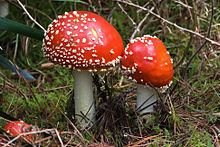
Ectomycorrhizal, A. muscaria forms symbiotic relationships with many trees, including pine, oak, spruce, fir, birch, and cedar. Commonly seen under introduced trees,[49] A. muscaria is the fungal equivalent of a weed in New Zealand, Tasmania and Victoria, forming new associations with southern beech (Nothofagus).[50] The species is also invading a rainforest in Australia, where it may be displacing the native species.[49] It appears to be spreading northwards, with recent reports placing it near Port Macquarie on the New South Wales north coast.[51] It was recorded under silver birch (Betula pendula) in Manjimup, Western Australia in 2010.[52] Although it has apparently not spread to eucalypts in Australia, it has been recorded associating with them in Portugal. Commonly found throughout the great Southern region of western Australia, it is regularly found growing on Pinus radiata.[53]
Toxicity
[edit]
A. muscaria poisoning has occurred in young children and in people who ingested the mushrooms for a hallucinogenic experience,[21][54][55] or who confused it with an edible species.
A. muscaria contains several biologically active agents, at least one of which, muscimol, is known to be psychoactive. Ibotenic acid, a neurotoxin, serves as a prodrug to muscimol, with a small amount likely converting to muscimol after ingestion. An active dose in adults is approximately 6 mg muscimol or 30 to 60 mg ibotenic acid;[56][57] this is typically about the amount found in one cap of Amanita muscaria.[58] The amount and ratio of chemical compounds per mushroom varies widely from region to region and season to season, which can further confuse the issue. Spring and summer mushrooms have been reported to contain up to 10 times more ibotenic acid and muscimol than autumn fruitings.[54]
Deaths from A. muscaria have been reported in historical journal articles and newspaper reports,[59][60][61] but with modern medical treatment, fatal poisoning from ingesting this mushroom is extremely rare.[62] Many books list A. muscaria as deadly,[63] but according to David Arora, this is an error that implies the mushroom is far more toxic than it is.[64] Furthermore, The North American Mycological Association has stated that there were "no reliably documented cases of death from toxins in these mushrooms in the past 100 years".[65]
The active constituents of this species are water-soluble, and boiling and then discarding the cooking water at least partly detoxifies A. muscaria.[66] Drying may increase potency, as the process facilitates the conversion of ibotenic acid to the more potent muscimol.[67] According to some sources, once detoxified, the mushroom becomes edible.[68][69] Patrick Harding describes the Sami custom of processing the fly agaric through reindeer.[70]
Pharmacology
[edit]

Muscarine, discovered in 1869,[71] was long thought to be the active hallucinogenic agent in A. muscaria. Muscarine binds with muscarinic acetylcholine receptors leading to the excitation of neurons bearing these receptors. The levels of muscarine in Amanita muscaria are minute when compared with other poisonous fungi[72] such as Inosperma erubescens, the small white Clitocybe species C. dealbata and C. rivulosa. The level of muscarine in A. muscaria is too low to play a role in the symptoms of poisoning.[73]
The major toxins involved in A. muscaria poisoning are muscimol (3-hydroxy-5-aminomethyl-1-isoxazole, an unsaturated cyclic hydroxamic acid) and the related amino acid ibotenic acid. Muscimol is the product of the decarboxylation (usually by drying) of ibotenic acid. Muscimol and ibotenic acid were discovered in the mid-20th century.[74][75] Researchers in England,[76] Japan,[77] and Switzerland[75] showed that the effects produced were due mainly to ibotenic acid and muscimol, not muscarine.[19][74] These toxins are not distributed uniformly in the mushroom. Most are detected in the cap of the fruit, a moderate amount in the base, with the smallest amount in the stalk.[78][79] Quite rapidly, between 20 and 90 minutes after ingestion, a substantial fraction of ibotenic acid is excreted unmetabolised in the urine of the consumer. Almost no muscimol is excreted when pure ibotenic acid is eaten, but muscimol is detectable in the urine after eating A. muscaria, which contains both ibotenic acid and muscimol.[57]
Ibotenic acid and muscimol are structurally related to each other and to two major neurotransmitters of the central nervous system: glutamic acid and GABA respectively. Ibotenic acid and muscimol act like these neurotransmitters, muscimol being a potent GABAA agonist, while ibotenic acid is an agonist of NMDA glutamate receptors and certain metabotropic glutamate receptors[80] which are involved in the control of neuronal activity. It is these interactions which are thought to cause the psychoactive effects found in intoxication.[21][58]
Muscazone is another compound that has more recently been isolated from European specimens of the fly agaric. It is a product of the breakdown of ibotenic acid by ultra-violet radiation.[81] Muscazone is of minor pharmacological activity compared with the other agents.[21] Amanita muscaria and related species are known as effective bioaccumulators of vanadium; some species concentrate vanadium to levels of up to 400 times those typically found in plants.[82] Vanadium is present in fruit-bodies as an organometallic compound called amavadine.[82] The biological importance of the accumulation process is unknown.[83]
Symptoms
[edit]Fly agarics are best known for the unpredictability of their effects. Depending on habitat and the amount ingested per body weight, effects can range from mild nausea and twitching to drowsiness, cholinergic crisis-like effects (low blood pressure, sweating and salivation), auditory and visual distortions, mood changes, euphoria, relaxation, ataxia, and loss of equilibrium (like with tetanus.)[54][55][58][60]
In cases of serious poisoning the mushroom causes delirium, somewhat similar in effect to anticholinergic poisoning (such as that caused by Datura stramonium), characterised by bouts of marked agitation with confusion, hallucinations, and irritability followed by periods of central nervous system depression. Seizures and coma may also occur in severe poisonings.[55][58] Symptoms typically appear after around 30 to 90 minutes and peak within three hours, but certain effects can last for several days.[33][57] In the majority of cases recovery is complete within 12 to 24 hours.[66] The effect is highly variable between individuals, with similar doses potentially causing quite different reactions.[54][57][84] Some people suffering intoxication have exhibited headaches up to ten hours afterwards.[57] Retrograde amnesia and somnolence can result following recovery.[58]
Treatment
[edit]Medical attention should be sought in cases of suspected poisoning. If the delay between ingestion and treatment is less than four hours, activated charcoal is given. Gastric lavage can be considered if the patient presents within one hour of ingestion.[85] Inducing vomiting with syrup of ipecac is no longer recommended in any poisoning situation.[86]

There is no antidote, and supportive care is the mainstay of further treatment for intoxication. Though sometimes referred to as a deliriant and while muscarine was first isolated from A. muscaria and as such is its namesake, muscimol does not have action, either as an agonist or antagonist, at the muscarinic acetylcholine receptor site, and therefore atropine or physostigmine as an antidote is not recommended.[87] If a patient is delirious or agitated, this can usually be treated by reassurance and, if necessary, physical restraints. A benzodiazepine such as diazepam or lorazepam can be used to control combativeness, agitation, muscular overactivity, and seizures.[54] Only small doses should be used, as they may worsen the respiratory depressant effects of muscimol.[88] Recurrent vomiting is rare, but if present may lead to fluid and electrolyte imbalances; intravenous rehydration or electrolyte replacement may be required.[58][89] Serious cases may develop loss of consciousness or coma, and may need intubation and artificial ventilation.[55][90] Hemodialysis can remove the toxins, although this intervention is generally considered unnecessary.[66] With modern medical treatment the prognosis is typically good following supportive treatment.[62][66]
Uses
[edit]Psychoactive
[edit]
The wide range of psychoactive effects have been variously described as depressant, sedative-hypnotic, psychedelic, dissociative, or deliriant; paradoxical effects such as stimulation may occur however. Perceptual phenomena such as synesthesia, macropsia, and micropsia may occur; the latter two effects may occur either simultaneously or alternatingly, as part of Alice in Wonderland syndrome, collectively known as dysmetropsia, along with related distortions pelopsia and teleopsia. Some users report lucid dreaming under the influence of its hypnotic effects. Unlike Psilocybe cubensis, A. muscaria cannot be commercially cultivated, due to its mycorrhizal relationship with the roots of pine trees. However, following the outlawing of psilocybin mushrooms in the United Kingdom in 2006, the sale of the still legal A. muscaria began increasing.[91]
Marija Gimbutas reported to R. Gordon Wasson that in remote areas of Lithuania, A. muscaria has been consumed at wedding feasts, in which mushrooms were mixed with vodka. She also reported that the Lithuanians used to export A. muscaria to the Sami in the Far North for use in shamanic rituals. The Lithuanian festivities are the only report that Wasson received of ingestion of fly agaric for religious use in Eastern Europe.[92]
Siberia
[edit]
A. muscaria was widely used as an entheogen by many of the indigenous peoples of Siberia. Its use was known among almost all of the Uralic-speaking peoples of western Siberia and the Paleosiberian-speaking peoples of the Russian Far East. There are only isolated reports of A. muscaria use among the Tungusic and Turkic peoples of central Siberia and it is believed that on the whole entheogenic use of A. muscaria was not practised by these peoples.[6] In western Siberia, the use of A. muscaria was restricted to shamans, who used it as an alternative method of achieving a trance state. (Normally, Siberian shamans achieve trance by prolonged drumming and dancing.) In eastern Siberia, A. muscaria was used by both shamans and laypeople alike, and was used recreationally as well as religiously.[6] In eastern Siberia, the shaman would take the mushrooms, and others would drink his urine.[93] This urine, still containing psychoactive elements, may be more potent than the A. muscaria mushrooms with fewer negative effects such as sweating and twitching, suggesting that the initial user may act as a screening filter for other components in the mushroom.[94]
The Koryak of eastern Siberia have a story about the fly agaric (wapaq) which enabled Big Raven to carry a whale to its home. In the story, the deity Vahiyinin ("Existence") spat onto earth, and his spittle became the wapaq, and his saliva becomes the warts. After experiencing the power of the wapaq, Raven was so exhilarated that he told it to grow forever on earth so his children, the people, could learn from it.[95] Among the Koryaks, one report said that the poor would consume the urine of the wealthy, who could afford to buy the mushrooms.[96] It was reported that the local reindeer would often follow an individual intoxicated by the muscimol mushroom, and if said individual were to urinate in snow the reindeer would become similarly intoxicated and the Koryak people's would use the drunken state of the reindeer to more easily rope and hunt them.[97]
Recent Rise in Popularity
[edit]As a result of a lack of regulation, the use of Amanita muscaria as a popular legal alternative to hallucinogens has grown exponentially in recent years. In 2024, Google searches for Amanita muscaria rose nearly 200% from the previous year, a trend that an article published in the American Journal of Preventative Medicine correlated with the sudden commercialization of Amanita muscaria products on the internet.[98]
While Amanita mushrooms are unscheduled in the United States, the sale of Amanita products exists in a legal gray area as they are listed as a poison by the FDA[99] and are not approved to be used in dietary supplements, with some drawing comparisons to the controversial legal status of hemp-derived cannabinoids.[98][100]
A recent outbreak of poisonings and at least one death associated with products containing Amanita muscaria extracts has sparked debates regarding the regulatory status of Amanita mushrooms and their psychoactive constituents.[98][101] These products often use misleading advertising, such as erroneous comparisons to Psilocybin mushrooms or simply not disclosing the inclusion of Amanita mushrooms on the packaging.[101][102]
Other reports and theories
[edit]The Finnish historian T. I. Itkonen mentions that A. muscaria was once used among the Sámi peoples. Sorcerers in Inari would consume fly agarics with seven spots.[103] In 1979, Said Gholam Mochtar and Hartmut Geerken published an article in which they claimed to have discovered a tradition of medicinal and recreational use of this mushroom among a Parachi-speaking group in Afghanistan.[104] There are also unconfirmed reports of religious use of A. muscaria among two Subarctic Native American tribes. Ojibwa ethnobotanist Keewaydinoquay Peschel reported its use among her people, where it was known as miskwedo (an abbreviation of the name oshtimisk wajashkwedo (= "red-top mushroom").[105][106] This information was enthusiastically received by Wasson, although evidence from other sources was lacking.[107] There is also one account of a Euro-American who claims to have been initiated into traditional Tlicho use of Amanita muscaria.[108]
Mycophilosopher Martijn Benders has proposed a novel evolutionary theory involving Amanita muscaria. In his book Amanita Muscaria – the Book of the Empress, Benders argues that a precursor of ibotenic acid, a compound found in the mushroom, was present in ancient seaweed and played a significant role in the evolution of life. According to this hypothesis, the compound influenced the twitching movements of early aquatic organisms, leading to the development of behaviors such as jumping onto land—a crucial step in the evolution of terrestrial species.[109]
The flying reindeer of Santa Claus, who is called Joulupukki in Finland, could symbolize the use of A. muscaria by Sámi shamans.[110][111][112] However, Sámi scholars and the Sámi peoples themselves refute any connection between Santa Claus and Sámi history or culture.[113]
"The story of Santa emerging from a Sámi shamanic tradition has a critical number of flaws," asserts Tim Frandy, assistant professor of Nordic Studies at the University of British Columbia and a member of the Sámi descendent community in North America. "The theory has been widely criticized by Sámi people as a stereotypical and problematic romanticized misreading of actual Sámi culture."[113]
Vikings
[edit]The notion that Vikings used A. muscaria to produce their berserker rages was first suggested by the Swedish professor Samuel Ödmann in 1784.[114] Ödmann based his theories on reports about the use of fly agaric among Siberian shamans. The notion has become widespread since the 19th century, but no contemporary sources mention this use or anything similar in their description of berserkers. Muscimol is generally a mild relaxant, but it can create a range of different reactions within a group of people.[115] It is possible that it could make a person angry, or cause them to be "very jolly or sad, jump about, dance, sing or give way to great fright".[115] Comparative analysis of symptoms have, however, since shown Hyoscyamus niger to be a better fit to the state that characterises the berserker rage.[116]
Soma
[edit]In 1968, R. Gordon Wasson proposed that A. muscaria was the soma talked about in the Rigveda of India,[117] a claim which received widespread publicity and popular support at the time.[118] He noted that descriptions of Soma omitted any description of roots, stems or seeds, which suggested a mushroom,[119] and used the adjective hári "dazzling" or "flaming" which the author interprets as meaning red.[120] One line described men urinating Soma; this recalled the practice of recycling urine in Siberia. Soma is mentioned as coming "from the mountains", which Wasson interpreted as the mushroom having been brought in with the Aryan migrants from the north.[121] Indian scholars Santosh Kumar Dash and Sachinanda Padhy pointed out that both eating of mushrooms and drinking of urine were proscribed, using as a source the Manusmṛti.[122] In 1971, Vedic scholar John Brough from Cambridge University rejected Wasson's theory and noted that the language was too vague to determine a description of Soma.[123] In his 1976 survey, Hallucinogens and Culture, anthropologist Peter T. Furst evaluated the evidence for and against the identification of the fly agaric mushroom as the Vedic Soma, concluding cautiously in its favour.[124] Kevin Feeney and Trent Austin compared the references in the Vedas with the filtering mechanisms in the preparation of Amanita muscaria and published findings supporting the proposal that fly-agaric mushrooms could be a likely candidate for the sacrament.[112] Other proposed candidates include Psilocybe cubensis, Peganum harmala,[125] and Ephedra.
Christianity
[edit]
Philologist, archaeologist, and Dead Sea Scrolls scholar John Marco Allegro postulated that early Christian theology was derived from a fertility cult revolving around the entheogenic consumption of A. muscaria in his 1970 book The Sacred Mushroom and the Cross.[126] This theory has found little support by scholars outside the field of ethnomycology. The book was widely criticized by academics and theologians, including Sir Godfrey Driver, emeritus Professor of Semitic Philology at Oxford University and Henry Chadwick, the Dean of Christ Church, Oxford.[127] Christian author John C. King wrote a detailed rebuttal of Allegro's theory in the 1970 book A Christian View of the Mushroom Myth; he notes that neither fly agarics nor their host trees are found in the Middle East, even though cedars and pines are found there, and highlights the tenuous nature of the links between biblical and Sumerian names coined by Allegro. He concludes that if the theory were true, the use of the mushroom must have been "the best kept secret in the world" as it was so well concealed for two thousand years.[128][129]
Fly trap
[edit]Amanita muscaria is traditionally used for catching flies possibly due to its content of ibotenic acid and muscimol, which lead to its common name "fly agaric". Recently, an analysis of nine different methods for preparing A. muscaria for catching flies in Slovenia have shown that the release of ibotenic acid and muscimol did not depend on the solvent (milk or water) and that thermal and mechanical processing led to faster extraction of ibotenic acid and muscimol.[130]
Culinary
[edit]
The toxins in A. muscaria are water-soluble: parboiling A. muscaria fruit bodies can detoxify them and render them edible,[68] although consumption of the mushroom as a food has never been widespread.[131] The consumption of detoxified A. muscaria has been practiced in some parts of Europe (notably by Russian settlers in Siberia) since at least the 19th century, and likely earlier. The German physician and naturalist Georg Heinrich von Langsdorff wrote the earliest published account on how to detoxify this mushroom in 1823. In the late 19th century, the French physician Félix Archimède Pouchet was a populariser and advocate of A. muscaria consumption, comparing it to manioc, an important food source in tropical South America that must also be detoxified before consumption.[68]
Use of this mushroom as a food source also seems to have existed in North America. A classic description of this use of A. muscaria by an African-American mushroom seller in Washington, D.C., in the late 19th century is described by American botanist Frederick Vernon Coville. In this case, the mushroom, after parboiling, and soaking in vinegar, is made into a mushroom sauce for steak.[132] It is also consumed as a food in parts of Japan. The most well-known current use as an edible mushroom is in Nagano Prefecture, Japan. There, it is primarily salted and pickled.[133]
A 2008 paper by food historian William Rubel and mycologist David Arora gives a history of consumption of A. muscaria as a food and describes detoxification methods. They advocate that Amanita muscaria be described in field guides as an edible mushroom, though accompanied by a description on how to detoxify it. The authors state that the widespread descriptions in field guides of this mushroom as poisonous is a reflection of cultural bias, as several other popular edible species, notably morels, are also toxic unless properly cooked.[68]
In culture
[edit]
The red-and-white spotted toadstool is a common image in many aspects of popular culture.[29] Garden ornaments and children's picture books depicting gnomes and fairies, such as the Smurfs, often show fly agarics used as seats, or homes.[29][135] Fly agarics have been featured in paintings since the Renaissance,[136] albeit in a subtle manner. For instance, in Hieronymus Bosch's painting, The Garden of Earthly Delights, the mushroom can be seen on the left-hand panel of the work.[137] In the Victorian era they became more visible, becoming the main topic of some fairy paintings.[138] Two of the most famous uses of the mushroom are in the Mario franchise (specifically two of the Super Mushroom power-up items and the platforms in several stages which are based on a fly agaric),[139][140] and the dancing mushroom sequence in the 1940 Disney film Fantasia.[141]
An account of the journeys of Philip von Strahlenberg to Siberia and his descriptions of the use of the mukhomor there was published in English in 1736. The drinking of urine of those who had consumed the mushroom was commented on by Anglo-Irish writer Oliver Goldsmith in his widely read 1762 novel, Citizen of the World.[142] The mushroom had been identified as the fly agaric by this time.[143] Other authors recorded the distortions of the size of perceived objects while intoxicated by the fungus, including naturalist Mordecai Cubitt Cooke in his books The Seven Sisters of Sleep and A Plain and Easy Account of British Fungi.[144] This observation is thought to have formed the basis of the effects of eating the mushroom in the 1865 popular story Alice's Adventures in Wonderland.[145] A hallucinogenic "scarlet toadstool" from Lappland is featured as a plot element in Charles Kingsley's 1866 novel Hereward the Wake based on the medieval figure of the same name.[146] Thomas Pynchon's 1973 novel Gravity's Rainbow describes the fungus as a "relative of the poisonous Destroying angel" and presents a detailed description of a character preparing a cookie bake mixture from harvested Amanita muscaria.[147] Fly agaric shamanism—in the context of a surviving Dionysian cult in the Peak District—is also explored in the 2003 novel Thursbitch by Alan Garner.[148]
See also
[edit]References
[edit]- ^ a b c Tulloss RE; Yang Z-L (2012). "Amanita muscaria Singer". Studies in the Genus Amanita Pers. (Agaricales, Fungi). Retrieved 2019-05-06.
- ^ a b c "Infraspecific taxa of muscaria". amanitaceae.org.
- ^ a b c Tulloss RE; Yang Z-L (2012). "Amanita muscaria subsp. flavivolvata Singer". Studies in the Genus Amanita Pers. (Agaricales, Fungi). Retrieved 2013-02-21.
- ^ a b c Tulloss RE; Yang Z-L (2012). "Amanita muscaria var. guessowii Veselý". Studies in the Genus Amanita Pers. (Agaricales, Fungi). Retrieved 2013-02-21.
- ^ "Standardized Common Names for Wild Species in Canada". National General Status Working Group. 2020.
- ^ a b c Nyberg, Harri (1992). "Religious use of hallucinogenic fungi: A comparison between Siberian and Mesoamerican cultures". Karstenia. 32 (2): 71–80. doi:10.29203/ka.1992.294.
- ^ Carboué, Quentin; Lopez, Michel (2021). "Amanita muscaria: Ecology, Chemistry, Myths". Encyclopedia. 1 (3): 905. doi:10.3390/encyclopedia1030069.
- ^ Li, Chen; Oberlies, Nicholas H. (2005). "The most widely recognized mushroom: Chemistry of the genus Amanita" (PDF). Life Sciences. 78 (5): 532–538. doi:10.1016/j.lfs.2005.09.003. PMID 16203016.
- ^ Biderman, Chris (2023-10-14). "They look delightful but California hospital warns against eating these poisonous mushrooms". Health & Medicine. Sacramento Bee. Sacramento, California, U.S. Retrieved 2024-02-23.
- ^ Wasson 1968, p. 198.
- ^ Magnus A. (1256). "Book II, Chapter 6; p. 87 and Book VI, Chapter 7; p. 345". De vegetabilibus.
- ^ a b Ramsbottom 1989, p. 44.
- ^ Clusius C. (1601). "Genus XII of the pernicious mushrooms". Rariorum plantarum historia.
- ^ Linnaeus C. (1745). Flora svecica [suecica] exhibens plantas per regnum Sueciae crescentes systematice cum differentiis specierum, synonymis autorum, nominibus incolarum, solo locorum, usu pharmacopæorum (in Latin). Stockholm: Laurentii Salvii.
- ^ Linnaeus C (1753). "Tomus II". Species Plantarum (in Latin). Vol. 2. Stockholm: Laurentii Salvii. p. 1172.
- ^ Simpson DP (1979). Cassell's Latin dictionary (5th ed.). London: Cassell Ltd. p. 883. ISBN 978-0-304-52257-6.
- ^ Hawksworth, David L. (2001). "The Naming of Fungi". In McLaughlin, David J.; McLaughlin, Esther G.; Lemke, Paul A. (eds.). Systematics and Evolution. pp. 171–192. doi:10.1007/978-3-662-10189-6_6. ISBN 978-3-642-08576-5.
- ^ Wasson 1968, p. 200.
- ^ a b Benjamin 1995, pp. 306–307.
- ^ Samorini, Giorgio (2002). Animals and psychedelics: the natural world and the instinct to alter consciousness. Inner Traditions/Bear. 823/1251 (67%) in Kindle edition. ISBN 978-0-89281-986-7.
- ^ a b c d Michelot D; Melendez-Howell LM. (2003). "Amanita muscaria: chemistry, biology, toxicology, and ethnomycology". Mycological Research. 107 (Pt 2): 131–46. doi:10.1017/S0953756203007305. PMID 12747324. S2CID 41451034.
- ^ Wasson 1968, p. 194.
- ^ a b Singer R. (1986). The Agaricales in modern taxonomy (4th ed.). Koenigstein, West Germany: Koeltz Scientific Books. ISBN 978-3-87429-254-2.
- ^ Jenkins DT (1986). Amanita of North America. Mad River Press. ISBN 978-0-916422-55-4.
- ^ Tulloss RE; Yang Z-L (2012). "Amanita sect. Amanita". Studies in the Genus Amanita Pers. (Agaricales, Fungi). Retrieved 2013-02-21.
- ^ Moncalvo JM; Drehmel D; Vilgalys R. (July 2000). "Variation in modes and rates of evolution in nuclear and mitochondrial ribosomal DNA in the mushroom genus Amanita (Agaricales, Basidiomycota): phylogenetic implications". Molecular Phylogenetics and Evolution. 16 (1): 48–63. Bibcode:2000MolPE..16...48M. doi:10.1006/mpev.2000.0782. PMID 10877939.
- ^ Drehmel D; Moncalvo JM; Vilgalys R. (1999). "Molecular phylogeny of Amanita based on large subunit ribosomal DNA sequences: implications for taxonomy and character evolution". Mycologia. 91 (4): 610–618. doi:10.2307/3761246. JSTOR 3761246.
- ^ Zeitlmayr L. (1976). Wild mushrooms: an illustrated handbook. Hertfordshire, UK: Garden City Press. ISBN 978-0-584-10324-3.
- ^ a b c Arora, D. (1986). Mushrooms demystified: a comprehensive guide to the fleshy fungi (2nd ed.). Berkeley: Ten Speed Press. pp. 282–83. ISBN 978-0-89815-169-5.
- ^ Sisson, Liv; Vigus, Paula (2023). Fungi of Aotearoa: a curious forager's field guide. Auckland, New Zealand: Penguin Books. p. 210. ISBN 978-1-76104-787-9. OCLC 1372569849.
- ^ Jordan P; Wheeler S. (2001). The ultimate mushroom book. Hermes House. ISBN 978-0-8317-3080-2.
- ^ Phillips R. (2006). Mushrooms. Pan MacMillan. p. 140. ISBN 978-0-330-44237-4.
- ^ a b Brvar, M.; Mozina, M.; Bunc, M. (May 2006). "Prolonged psychosis after Amanita muscaria ingestion". Wien. Klin. Wochenschr. 118 (9–10): 294–7. doi:10.1007/s00508-006-0581-6. PMID 16810488.
- ^ Haas H. (1969). The young specialist Looks at fungi. Burke. p. 94. ISBN 978-0-222-79414-7.
- ^ Krieger LCC (1967). The mushroom handbook. Dover. ISBN 978-0-486-21861-8.
- ^ Grey P. (2005). Fungi Down Under: the Fungimap guide to Australian fungi. Melbourne: Royal Botanic Gardens. p. 21. ISBN 978-0-646-44674-5.
- ^ Benjamin 1995, pp. 303–304.
- ^ a b c d Geml J; Laursen GA; O'Neill K; Nusbaum HC; Taylor DL (January 2006). "Beringian origins and cryptic speciation events in the fly agaric (Amanita muscaria)". Molecular Ecology. 15 (1): 225–39. Bibcode:2006MolEc..15..225G. doi:10.1111/j.1365-294X.2005.02799.x. PMID 16367842.
- ^ Geml, J.; Tulloss, R. E.; Laursen, G. A. (2008). "Evidence for strong inter- and intracontinental phylogeographic structure in Amanita muscaria, a wind-dispersed ectomycorrhizal basidiomycete". Molecular Phylogenetics and Evolution. 48 (2): 694–701. Bibcode:2008MolPE..48..694G. doi:10.1016/j.ympev.2008.04.029. PMID 18547823.
- ^ Tulloss, R. E. (2012). "Amanita breckonii Ammirati & Thiers". Studies in the Genus Amanita Pers. (Agaricales, Fungi) – Tulloss RE, Yang Z-L. Retrieved 2013-02-21.
- ^ Tulloss, R. E. (2012). "Amanita gioiosa S. Curreli ex S. Curreli". Studies in the Genus Amanita Pers. (Agaricales, Fungi) – Tulloss RE, Yang Z-L. Retrieved 2013-02-21.
- ^ Tulloss, R. E. (2012). "Amanita heterochroma S. Curreli". Studies in the Genus Amanita Pers. (Agaricales, Fungi) – Tulloss RE, Yang Z-L. Retrieved 2013-02-21.
- ^ "Amanita muscaria var. inzengae - Amanitaceae.org - Taxonomy and Morphology of Amanita and Limacella". www.amanitaceae.org.
- ^ Benjamin 1995, p. 305.
- ^ Reid, Derek A (1980). "A Monograph of the Australian Species of Amanita Pers. ex Hook. (Fungi)". Australian Journal of Botany. 10 (8): 1–96. doi:10.1071/BT8008001.
- ^ Segedin, Barbara P.; Pennycook, S. R. (June 2001). "A nomenclatural checklist of agarics, boletes, and related secotioid and gasteromycetous fungi recorded from New Zealand". New Zealand Journal of Botany. 39 (2): 285–348. Bibcode:2001NZJB...39..285S. doi:10.1080/0028825X.2001.9512739.
- ^ Reid DA; Eicker A. (1991). "South African fungi: the genus Amanita". Mycological Research. 95 (1): 80–95. doi:10.1016/S0953-7562(09)81364-6.
- ^ Wartchow F, Maia LC, de Queirox Cavalcanti MA (2013). "Taxonomic studies of Amanita muscaria (L.) Lam (Amanitaceae, Agaricomycetes) and its infraspecific taxa in Brazil". Acta Botanica Brasilica. 27 (1): 31–39. doi:10.1590/S0102-33062013000100005.
- ^ a b Fuhrer BA (2005). A field guide to Australian fungi. Melbourne: Bloomings Books. p. 24. ISBN 978-1-876473-51-8.
- ^ Hall IR; Stephenson SE; Buchanan PK; Yn W; Cole AL (2003). Edible and poisonous mushrooms of the world. New Zealand Institute for Crop & Food Research Limited. pp. 130–1. ISBN 978-0-478-10835-4.
- ^ May T. (2006). "News from the Fungimap president". Fungimap Newsletter. 29: 1.
- ^ Robinson R (2010). "First Record of Amanita muscaria in Western Australia" (PDF). Australasian Mycologist. 29 (1): 4–6.
- ^ Keane PJ; Kile GA; Podger FD (2000). Diseases and pathogens of eucalypts. Canberra: CSIRO Publishing. p. 85. ISBN 978-0-643-06523-9.
- ^ a b c d e Benjamin, Denis R. (January 1992). "Mushroom Poisoning in Infants and Children: The Amanita Pantherina/Muscaria Group". Journal of Toxicology: Clinical Toxicology. 30 (1): 13–22. doi:10.3109/15563659208994442. PMID 1347320.
- ^ a b c d Hoegberg LC; Larsen L; Sonne L; Bang J; Skanning PG. "Three cases of Amanita muscaria ingestion in children: two severe courses". pp. 407–408. In: "Abstracts of the XXVIII International Congress of the European Association of Poison Centres and Clinical Toxicologists, May 6–9, 2008, Seville, Spain". Clinical Toxicology. 46 (5): 351–421. January 2008. doi:10.1080/15563650802071703. PMID 18568796.
- ^ Theobald, W; Büch, O; Kunz, HA; Krupp, P; Stenger, EG; Heimann, H (March 1968). "Pharmakologische und experimental psychologische Untersuchungen mit 2 Inhaltsstoffen des Fliegenpilzes (Amanita muscaria)" [Pharmacological and experimental psychological studies with 2 components of fly agaric (Amanita muscaria)]. Arzneimittel-Forschung (in German). 18 (3): 311–315. PMID 5696006.
- ^ a b c d e Chilton WS (1975). "The course of an intentional poisoning". MacIlvanea. 2: 17.
- ^ a b c d e f Satora, L.; Pach, D.; Butryn, B.; Hydzik, P.; Balicka-Slusarczyk, B. (June 2005). "Fly agaric (Amanita muscaria) poisoning, case report and review". Toxicon. 45 (7): 941–3. Bibcode:2005Txcn...45..941S. doi:10.1016/j.toxicon.2005.01.005. PMID 15904689.
- ^ Cagliari GE (1897). "Mushroom poisoning". Medical Record. 52: 298.
- ^ a b Buck, R. W. (August 1963). "Toxicity of Amanita muscaria". JAMA. 185 (8): 663–4. doi:10.1001/jama.1963.03060080059020. PMID 14016551.
- ^ "THE STUDY OF MYCOLOGY: Vecchi's Death Said to be Due to a Deliberate Experiment with Poisonous Mushrooms. GROWING POPULAR INTEREST Clubs Formed in This City, Boston, Philadelphia, and Washington -- Views of Prof. Underwood of Columbia University". The New York Times. 19 December 1897. p. 12. ProQuest 95504145.
- ^ a b Tupalska-Wilczyńska, Krystyna; Ignatowicz, Roman; Poziemski, Andrzej; Wójcik, Halina; Wilczyński, Grzegorz (1996). "Zatrucia muchomorami plamistym i czerwonym—patogeneza, objawy, leczenie" [Poisoning with spotted and red mushrooms—pathogenesis, symptoms, treatment]. Wiadomosci Lekarskie (in Polish). 49 (1–6): 66–71. PMID 9173659.
- ^ Phillips, Roger (2010). Mushrooms and Other Fungi of North America. Buffalo, NY: Firefly Books. p. 16. ISBN 978-1-55407-651-2.
- ^ Arora, Mushrooms demystified, p. 894.
- ^ "Mushroom poisoning syndromes". North American Mycological Association (NAMA) website. NAMA. Archived from the original on 4 April 2009. Retrieved 2009-03-22.
- ^ a b c d Piqueras, J. (10 January 1990). "Amanita muscaria, Amanita pantherina and others". IPCS INTOX Databank. Retrieved 2008-12-08.
- ^ Benjamin 1995, p. 310.
- ^ a b c d Rubel, W.; Arora, D. (2008). "A Study of Cultural Bias in Field Guide Determinations of Mushroom Edibility Using the Iconic Mushroom, Amanita Muscaria,as an Example". Economic Botany. 62 (3): 223–43. Bibcode:2008EcBot..62..223R. doi:10.1007/s12231-008-9040-9.
- ^ Shaw, Hank (2011-12-24). "How to Safely Eat Amanita Muscaia". honest-food.net. Archived from the original on 2016-03-04.
- ^ Dr. Patrick Harding - Unwrapping the Mysteries of Christmas on YouTube
- ^ Schmiedeberg O.; Koppe R. (1869). Das Muscarin, das giftige Alkaloid des Fliegenpilzes (in German). Leipzig: F.C.W. Vogel. OCLC 6699630.
- ^ Eugster, Conrad Hans (July 1968). "Wirkstoffe aus dem Fliegenpilz" [Active substances from the toadstool]. Die Naturwissenschaften (in German). 55 (7): 305–313. Bibcode:1968NW.....55..305E. doi:10.1007/BF00600445. PMID 4878064.
- ^ Benjamin 1995, p. 306.
- ^ a b Bowden, K.; Drysdale, A. C.; Mogey, G. A. (June 1965). "Constituents of Amanita muscaria". Nature. 206 (991): 1359–60. Bibcode:1965Natur.206.1359B. doi:10.1038/2061359a0. PMID 5891274.
- ^ a b Eugster, C. H.; Müller, G. F.; Good, R. (June 1965). "[The active ingredients from Amanita muscaria: ibotenic acid and muscazone]". Tetrahedron Lett. (in German). 6 (23): 1813–5. doi:10.1016/S0040-4039(00)90133-3. PMID 5891631.
- ^ Bowden, K.; Drysdale, A. C. (March 1965). "A novel constituent of Amanita muscaria". Tetrahedron Lett. 6 (12): 727–8. doi:10.1016/S0040-4039(01)83973-3. PMID 14291871.
- ^ 薬 学 雑 誌. "イ ボ テ ン 酸 の 構 造" [Structure of Ibotenic Acid] (in Japanese). pp. 1232–1233. In: Takemoto, Tsunematsu; Nakajima, Tadashi; Yokobe, Tetsuro; Sakuma, Reiko; Fujitani, Kazuyoshi; Aoyagi, Yoshiaki; Masaki, Yukio (December 1964). "Communication to the Editor". Yakugaku Zasshi. 84 (12): 1230–1236. doi:10.1248/yakushi1947.84.12_1230.
- ^ Lampe, K.F., 1978. "Pharmacology and therapy of mushroom intoxications". In: Rumack, B.H., Salzman, E. (Eds.), Mushroom Poisoning: Diagnosis and Treatment. CRC Press, Boca Raton, FL, pp. 125–169
- ^ Tsunoda, Koujun; Inoue, Noriko; Aoyagi, Yasuo; Sugahara, Tatsuyuki (1993). "Changes in Concentration of Ibotenic Acid and Muscimol in the Fruit Body of Amanita muscaria during the Reproduction Stage". Food Hygiene and Safety Science (Shokuhin Eiseigaku Zasshi). 34 (1): 18–24_1. doi:10.3358/shokueishi.34.18.
- ^ Jørgensen, C. G.; Bräuner-Osborne, H.; Nielsen, B.; et al. (May 2007). "Novel 5-substituted 1-pyrazolol analogues of ibotenic acid: synthesis and pharmacology at glutamate receptors". Bioorganic & Medicinal Chemistry. 15 (10): 3524–38. doi:10.1016/j.bmc.2007.02.047. PMID 17376693.
- ^ Fritz, H.; Gagneux, A.R.; Zbinden, R.; Geigy, J.R.; Basle, S.A.; Eugster, C.H. (January 1965). "The structure of muscazone". Tetrahedron Letters. 6 (25): 2075–2076. doi:10.1016/S0040-4039(00)90156-4.
- ^ a b Garner, C.David; Armstrong, Elaine M; Berry, Rober E; Beddoes, Roy L; Collison, David; Cooney, J.Jon A; Ertok, S.Nigar; Helliwell, Madeleine (May 2000). "Investigations of Amavadin". Journal of Inorganic Biochemistry. 80 (1–2): 17–20. doi:10.1016/s0162-0134(00)00034-9. PMID 10885458.
- ^ Hubregtse, Ton; Neeleman, Ernst; Maschmeyer, Thomas; Sheldon, Roger A.; Hanefeld, Ulf; Arends, Isabel W.C.E. (May 2005). "The first enantioselective synthesis of the amavadin ligand and its complexation to vanadium". Journal of Inorganic Biochemistry. 99 (5): 1264–1267. doi:10.1016/j.jinorgbio.2005.02.004. PMID 15833352.
- ^ Ott, J. (1976). Hallucinogenic Plants of North America. Berkeley, CA: Wingbow Press. ISBN 978-0-914728-15-3.
- ^ Vale, J. A.; Kulig, K.; American Academy of Clinical Toxicology (2004). "Position paper: gastric lavage". Journal of Toxicology: Clinical Toxicology. 42 (7). European Association of Poisons Centres and Clinical Toxicologists: 933–43. doi:10.1081/CLT-200045006. PMID 15641639.
- ^ American Academy Of Clinical Toxico; European Association Of Poisons Cen (2004). "Position paper: Ipecac syrup". Journal of Toxicology: Clinical Toxicology. 42 (2): 133–43. doi:10.1081/CLT-120037421. PMID 15214617.
- ^ Dart, R. C. (2004). Medical toxicology. Philadelphia, PA: Lippincott Williams & Wilkins. pp. 1719–35. ISBN 978-0-7817-2845-4.
- ^ Brent, J.; Wallace, K. L.; Burkhart, K. K.; Phillips, S. D.; Donovan, J. W. (2005). Critical care toxicology: diagnosis and management of the critically poisoned patient. Philadelphia, PA: Elsevier Mosby. pp. 1263–75. ISBN 978-0-8151-4387-1.
- ^ Benjamin 1995, p. 313.
- ^ Bosman, C. K.; Berman, L.; Isaacson, M.; Wolfowitz, B.; Parkes, J. (October 1965). "Mushroom poisoning caused by Amanita pantherina. Report of 4 cases". South African Medical Journal. 39 (39): 983–86. PMID 5892794.
- ^ Hallucinogenic mushrooms an emerging trend case study (PDF). Lisbon: European Monitoring Centre for Drugs and Drug Addiction. 2006. p. 17. ISBN 978-92-9168-249-2. Archived from the original (PDF) on 2012-03-29. Retrieved 2009-02-13.
- ^ Wasson, R. Gordon (1980). The Wondrous Mushroom: Mycolatry in Mesoamerica. McGraw-Hill. pp. 43–44. ISBN 978-0-07-068443-0.
- ^ Wasson 1968, p. 161.
- ^ Diaz, J. (1996). How Drugs Influence Behavior: A Neurobehavioral Approach. Upper Saddle River, N.J.: Prentice Hall. ISBN 978-0-02-328764-0.
- ^ Ramsbottom 1989, p. 45.
- ^ Wasson 1968, pp. 234–235.
- ^ Lee, MR; Dukan, E; Milne, I (March 2018). "Amanita Muscaria (Fly Agaric): From a Shamanistic Hallucinogen to the Search for Acetylcholine". Journal of the Royal College of Physicians of Edinburgh. 48 (1): 85–91. doi:10.4997/jrcpe.2018.119. PMID 29741535.
- ^ a b c Leas, Eric (June 10, 2024). "Need for a Public Health Response to the Unregulated Sales of Amanita muscaria Mushrooms". American Journal of Preventive Medicine. 67 (3): 458–463. doi:10.1016/j.amepre.2024.05.006. PMID 38864780.
- ^ Bad Bug Book (2nd ed.). United States: Food and Drug Administration. 2012. p. 222. ISBN 978-1973853237.
- ^ Miller, Patricia (2024-01-25). "Can Brands Create Quality, Compliant Amanita Mushroom Products?". Cannabis & Tech Today. Retrieved 2024-07-15.
- ^ a b Blum, Dani (2024-06-10). "Mushroom Edibles Recalled After Spate of Serious Illnesses". The New York Times. ISSN 0362-4331. Retrieved 2024-07-14.
- ^ Schuster-Bruce, Catherine. "A legal psychedelic mushroom species is being sold in the US. It can cause euphoria — or 'temporary insanity'". Business Insider. Retrieved 2024-07-14.
- ^ Wasson 1968, p. 279.
- ^ Mochtar, S. G.; Geerken, H. (1979). "The Hallucinogens Muscarine and Ibotenic Acid in the Middle Hindu Kush: A contribution on traditional medicinal mycology in Afghanistan". Afghanistan Journal (in German). 6. Translated by P. G. Werner: 62–65. Archived from the original on 17 February 2009. Retrieved 2009-02-23.
Several Shutulis asserted that Amanita-extract was administered orally as a medicine for treatment of psychotic conditions, as well as externally as a therapy for localised frostbite.
- ^ Peschel, Keewaydinoquay (1978). Puhpohwee for the people: a narrative account of some uses of fungi among the Ahnishinaubeg. Cambridge, MA: Botanical Museum of Harvard University. ISBN 978-1-879528-18-5.
- ^ Navet, E. (1988). "Les Ojibway et l'Amanite tue-mouche (Amanita muscaria). Pour une éthnomycologie des Indiens d'Amérique du Nord". Journal de la Société des Américanistes (in French). 74 (1): 163–80. doi:10.3406/jsa.1988.1334.
- ^ Letcher 2006, p. 149.
- ^ Larsen, S. (1976). The Shaman's Doorway. New York, NY: Station Hill Press. ISBN 978-0-89281-672-9.
- ^ Benders, Martijn (2024). "Amanita Muscaria – the Book of the Empress". martijnbenders.nl. Retrieved 2025-01-08.
- ^ Xulu, Melanie (2017-12-12). "Santa Claus the Magic Mushroom & the Psychedelic Origins of Christmas". MOOF. Retrieved 2020-12-26.
- ^ "Magic mushrooms & Reindeer - Weird Nature - BBC animals - YouTube". www.youtube.com. 26 January 2009. Archived from the original on 2021-12-11. Retrieved 2020-12-26.
- ^ a b Feeney 2020, p. [page needed].
- ^ a b Campbell, Olivia (Dec 21, 2023). "What does Santa have to do with … psychedelic mushrooms?". National Geographic. Retrieved 2023-12-22.
- ^ (in Swedish) Ödmann S. (1784) Försök at utur Naturens Historia förklara de nordiska gamla Kämpars Berserka-gang (An attempt to Explain the Berserk-raging of Ancient Nordic Warriors through Natural History). Kongliga Vetenskaps Academiens nya Handlingar 5: 240–247 (In: Wasson 1968, p. [page needed]
- ^ a b Hoffer, A.; Osmond, H. (1967). The Hallucinogens. Academic Press. pp. 443–54. ISBN 978-0-12-351850-7.
- ^ Fatur, Karsten (November 2019). "Sagas of the Solanaceae: Speculative ethnobotanical perspectives on the Norse berserkers". Journal of Ethnopharmacology. 244: 112151. doi:10.1016/j.jep.2019.112151. PMID 31404578.
- ^ Wasson 1968, p. 10.
- ^ Letcher 2006, p. 145.
- ^ Wasson, Soma, p. 18.
- ^ Wasson 1968, pp. 36–37.
- ^ Wasson 1968, pp. 22–24.
- ^ Letcher 2006, p. 146.
- ^ Brough, John (June 1971). "Soma and Amanita muscaria". Bulletin of the School of Oriental and African Studies. 34 (2): 331–362. doi:10.1017/S0041977X0012957X.
- ^ Furst 1976, pp. 96–108.
- ^ Flattery & Schwartz 1989, p. [page needed].
- ^ Allegro, J. (1970). The Sacred Mushroom and the Cross: A Study of the Nature and Origins of Roman Theology within the Fertility Cults of the Ancient Near East. London: Hodder & Stoughton. ISBN 978-0-340-12875-6.
- ^ Letcher 2006, p. 160.
- ^ King, J. C. (1970). A Christian View of the Mushroom Myth. London: Hodder & Stoughton. ISBN 978-0-340-12597-7.[page needed]
- ^ Letcher 2006, p. 161.
- ^ Lumpert (2016). "Catching flies with Amanita muscaria: traditional recipes from Slovenia and their efficacy in the extraction of ibotenic acid". Journal of Ethnopharmacology. 187: 1–8. doi:10.1016/j.jep.2016.04.009. PMID 27063872.
- ^ Viess, Debbie. "Further Reflections on Amanita muscaria as an Edible Species"
- ^ Coville, F. V. 1898. Observations on Recent Cases of Mushroom Poisoning in the District of Columbia. United States Department of Agriculture, Division of Botany. U.S. Government Printing office, Washington, D.C.
- ^ Phipps, Allan (2000). Japanese use of Beni-Tengu-Dake (Amanita Muscaria) and the efficacy of traditional detoxification methods (Thesis).[page needed]
- ^ "Art Registry: 1750–1850". Mykoweb. Archived from the original on 2 February 2009. Retrieved 2009-02-26.
- ^ Benjamin 1995, p. 295.
- ^ "The Registry of Mushrooms in Works of Art". Mykoweb. Archived from the original on 1 February 2009. Retrieved 2009-02-16.
- ^ Michelot, Didier; Melendez-Howell, Leda Maria (February 2003). "Amanita muscaria: chemistry, biology, toxicology, and ethnomycology". Mycological Research. 107 (2): 131–146. doi:10.1017/s0953756203007305. PMID 12747324.
- ^ "Mushrooms in Victorian Fairy Paintings, by Elio Schachter". Mushroom, the Journal of Wild Mushrooming. Archived from the original on 15 January 2009. Retrieved 2009-02-16.
- ^ "The Top 11 Video Game Powerups". UGO Networks. Archived from the original on October 28, 2008.
- ^ Li, Chen; Oberlies, Nicholas H. (December 2005). "The most widely recognized mushroom: Chemistry of the genus Amanita" (PDF). Life Sciences. 78 (5): 532–538. doi:10.1016/j.lfs.2005.09.003. PMID 16203016.
- ^ Ramsbottom 1989, p. 43.
- ^ Letcher 2006, p. 122.
- ^ Letcher 2006, p. 123.
- ^ Letcher 2006, p. 125.
- ^ Letcher 2006, p. 126.
- ^ Letcher 2006, p. 127.
- ^ Pynchon, T. (1995). Gravity's Rainbow. New York: Penguin Books. pp. 92–93. ISBN 978-0-09-953321-4.
- ^ Letcher 2006, p. 129.
Works cited
[edit]- Allegro, John (2009). The sacred mushroom and the cross (40th anniversary ed.). Crestline, CA: Gnostic Media. ISBN 978-0-9825562-7-6.
- Arora, David (1986). Mushrooms demystified: a comprehensive guide to the fleshy fungi (2nd ed.). Berkeley: Ten Speed Press. ISBN 978-0-89815-169-5.
- Benjamin, Denis R. (1995). Mushrooms: poisons and panaceas—a handbook for naturalists, mycologists and physicians. New York: WH Freeman and Company. ISBN 978-0-7167-2600-5.
- Feeney, Kevin M. (2020). Fly Agaric: A Compendium of History, Pharmacology, Mythology, & Exploration. Fly Agaric Press. ISBN 978-0-578-71442-4.
- Flattery, David Stophlet; Schwartz, Martin (1989). Haoma and Harmaline: The Botanical Identity of the Indo-Iranian Sacred Hallucinogen 'soma' and Its Legacy in Religion, Language, and Middle-Eastern Folklore. University of California Press. ISBN 978-0-520-09627-1.
- Furst, Peter T. (1976). Hallucinogens and Culture. Chandler & Sharp. ISBN 978-0-88316-517-1.
- Letcher, Andy (2006). Shroom: A Cultural history of the magic mushroom. London: Faber and Faber. ISBN 978-0-571-22770-9.
- Ramsbottom, John (1989). Mushrooms and Toadstools. Penguin. ISBN 978-1-870630-09-2.
- Wasson, R. Gordon (1968). Soma: Divine Mushroom of Immortality. Harcourt Brace Jovanovick. ISBN 978-0-88316-517-1.
External links
[edit]- Webpages on Amanita species by Tulloss and Yang Zhuliang
- Amanita on erowid.org
- Aminita muscaria, Amanita pantherina and others (Group PIM G026) by IPCS INCHEM
